
Doris Duke and James Cromwell arrived in Honolulu in August 1935 as the final stop on their honeymoon tour and the Cromwells extended their island stay by four months.

Doris Duke described the Hawaiian islands as “…one of the most beautiful places in the world. It has a marvelous climate all year round, and I love the ocean, and I like the people.”
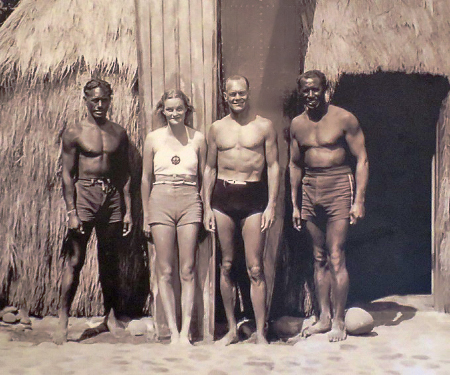
1935, Duke fell in love with Hawai’i’s natural beauty and multicultural environment and decided to build a residence. (above Duke and James Cromwell, Sam Kahanamoku (lft) and Chick Daniels in Waikiki.

On her honeymoon, traveling through the Middle East, India, Indonesia and China, Duke became fascinated with the rich cultural traditions, in particular the Islamic ones, she encountered.

The Mughal Garden, adjacent to the entry court, was influenced by Duke's travels to Humayun's tomb, the Taj Mahal, and the Red Fort and Agra Fort gardens, all in India.
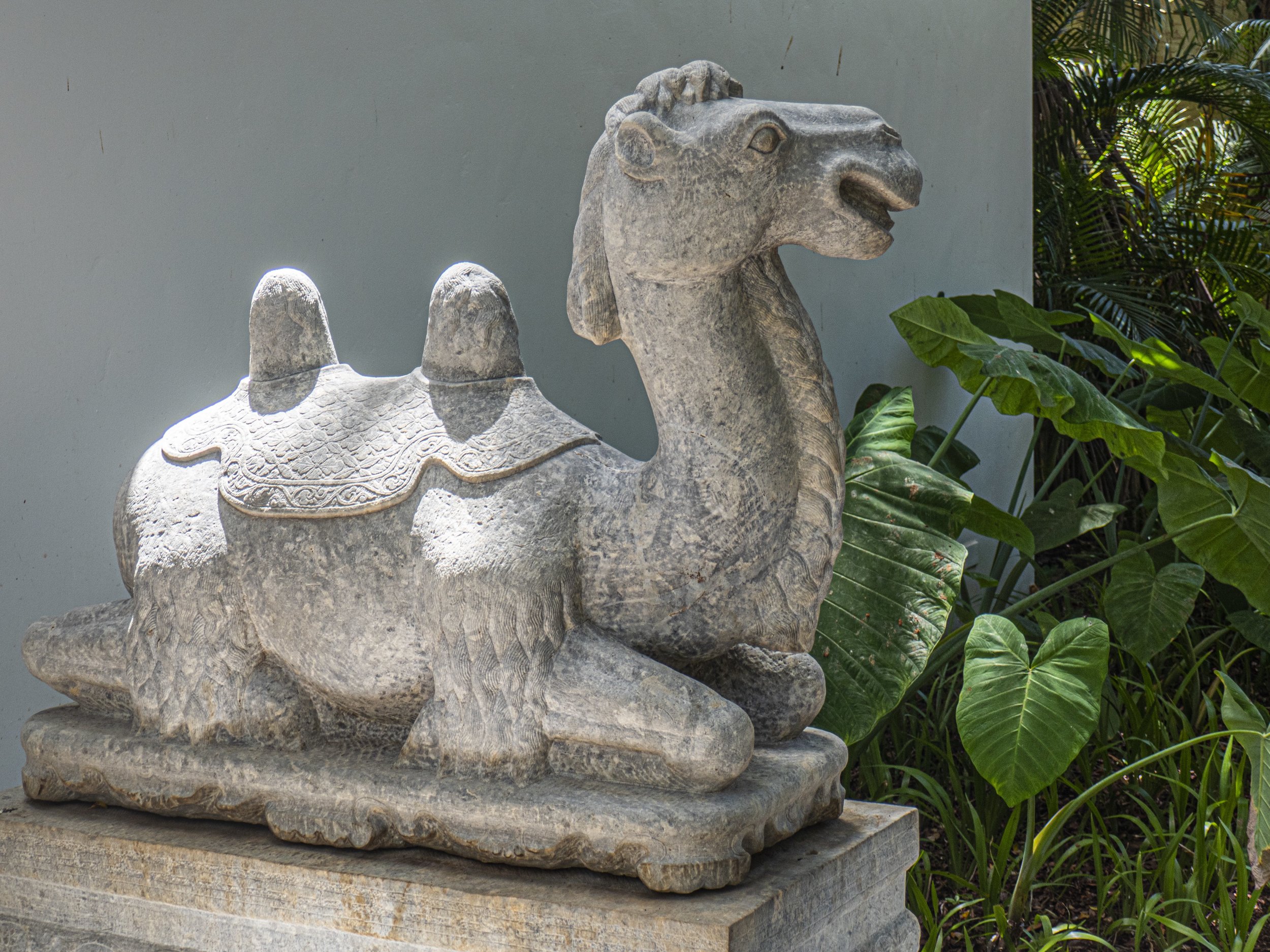
Doris Duke acquired a pair of 18th century Chinese stone camels not long after Shangri La was built and immediately located them at the entry to the main house where they remain to this day.
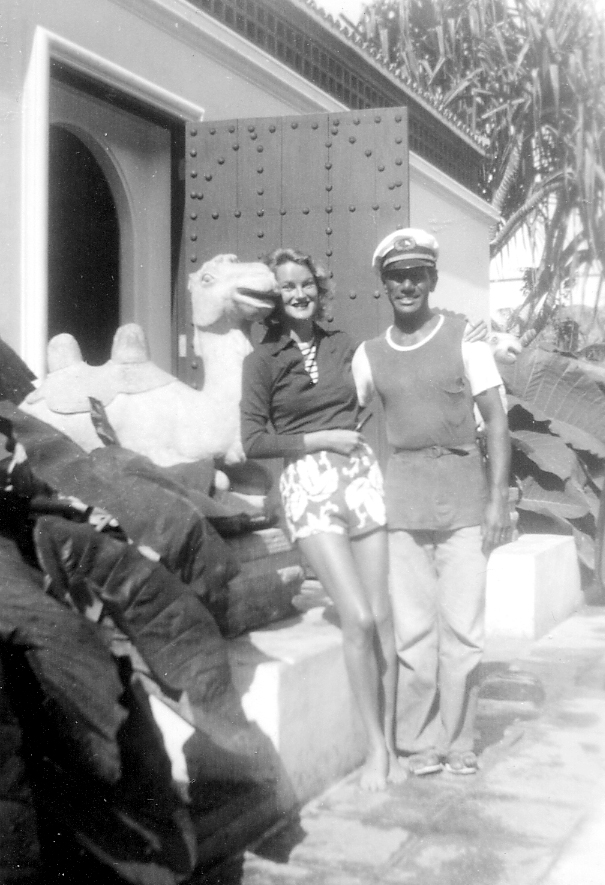
Doris Duke with Sam Kahanamoku (bronze medalist in the 100-meter free-style swim, 1924 Olympics) in 1938 (with camel). Their friendship continued until his death in 1966.
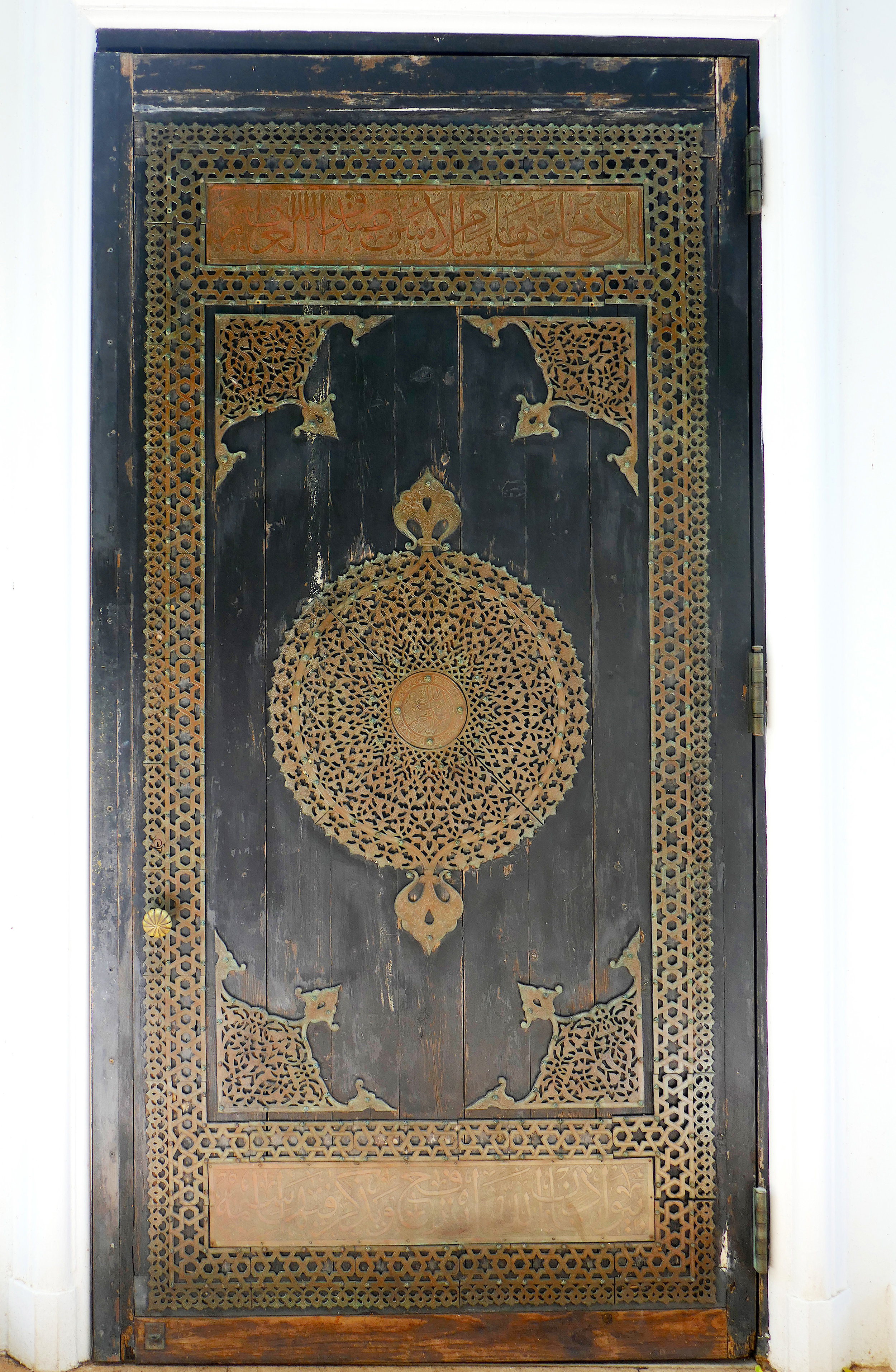
The front door to Shangri La was made in either Egypt or Syria around 1900 with wood and a copper alloy. (I could not find translations for the arabic inscriptions on the door.)
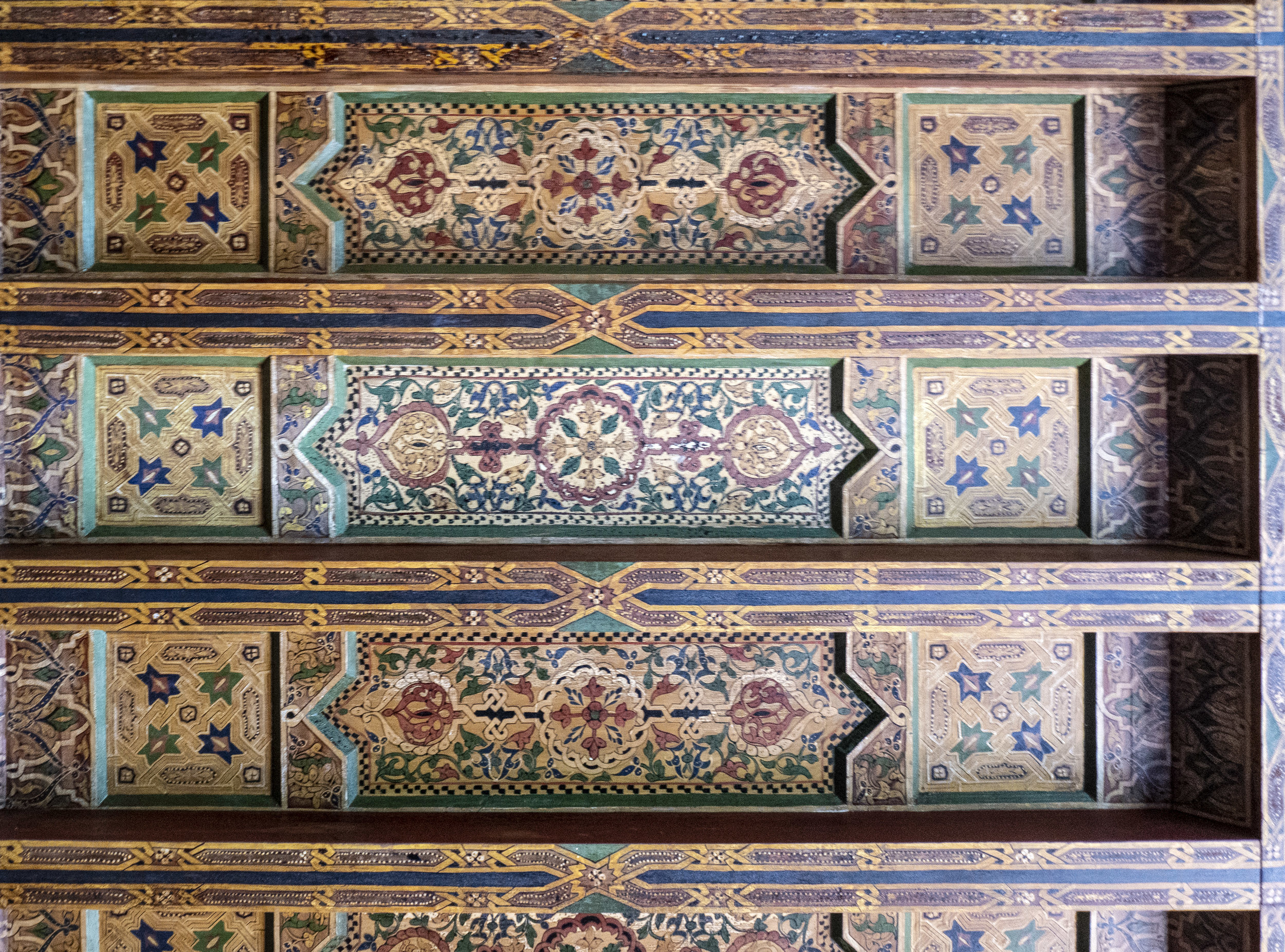
The fine workmanship of the foyer ceiling that was custom-made for Shangri La by Moroccan artisans in 1937 working under the supervision of the Rabat-based firm S.A.L.A.M. René Martin.
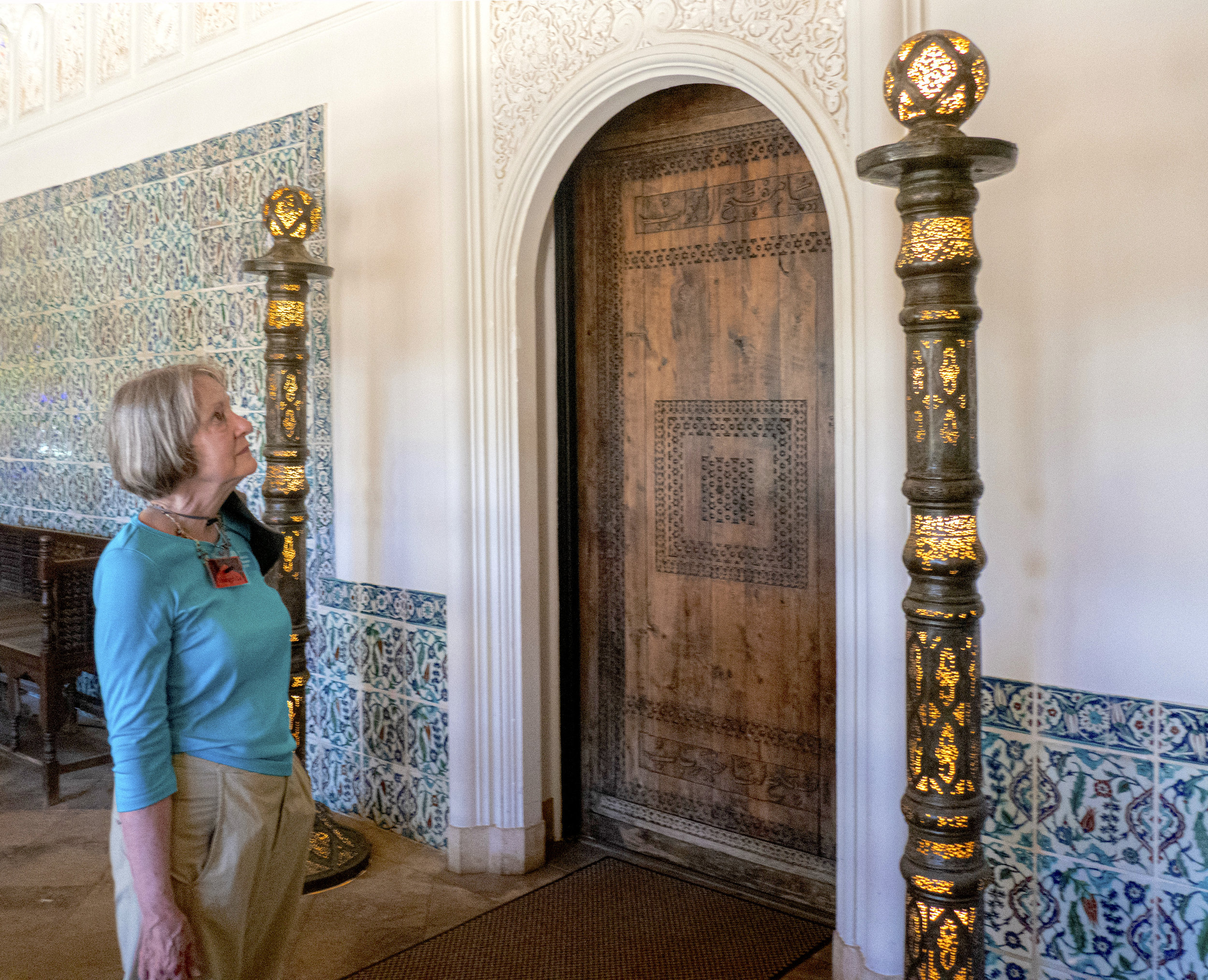
The foyer's copper alloy and silver floor lamps were made in either Iran, Egypt or Syria in the late 19th to early 20th c. Duke bought the foyer's 17th and 19th c. Turkish wall-tiles in Italy in 1937.
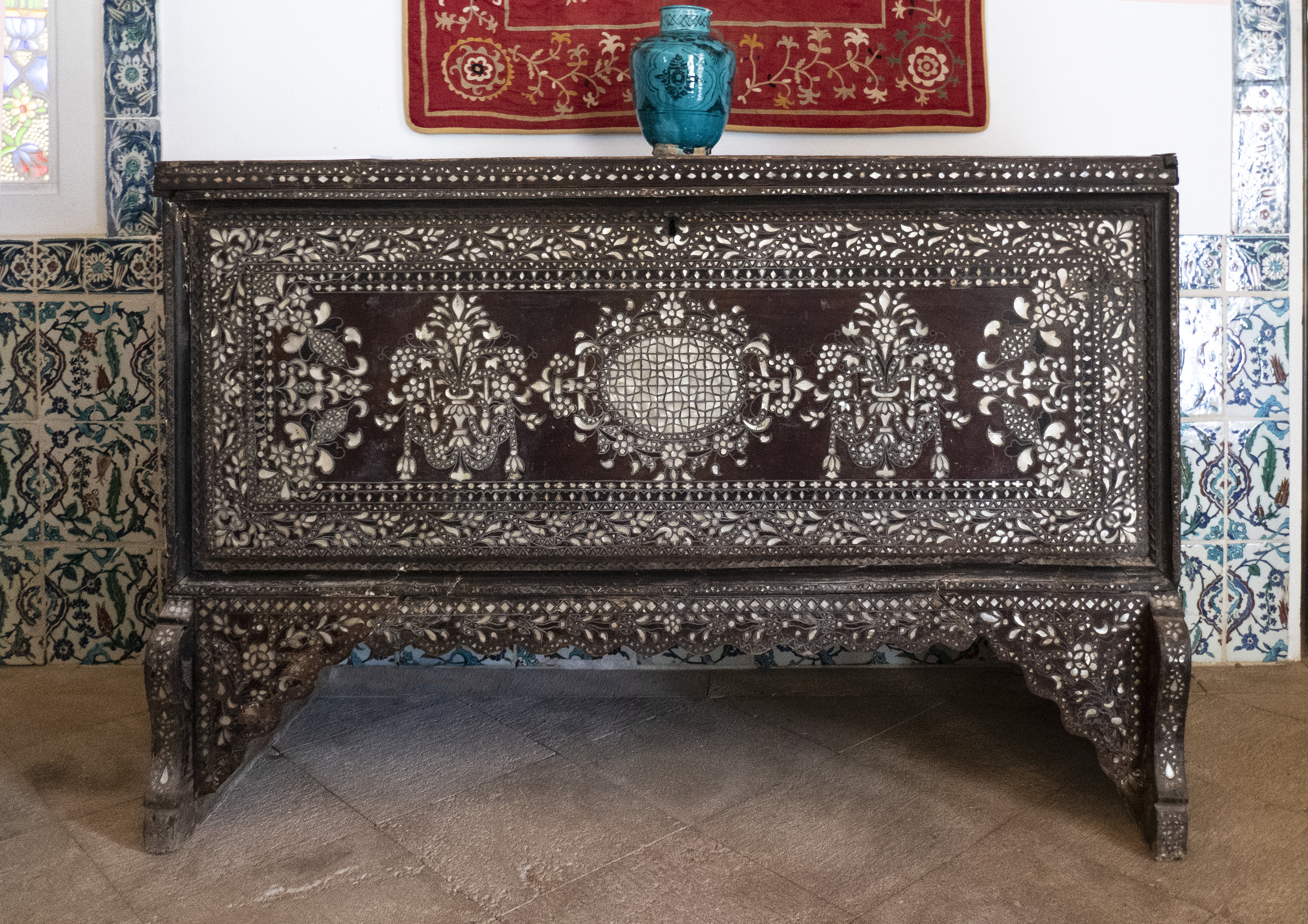
Also located in the foyer is this beautiful "Mother-of-Pearl Inlaid Wooden Chest with Floral Motifs" from 19th century Syria.
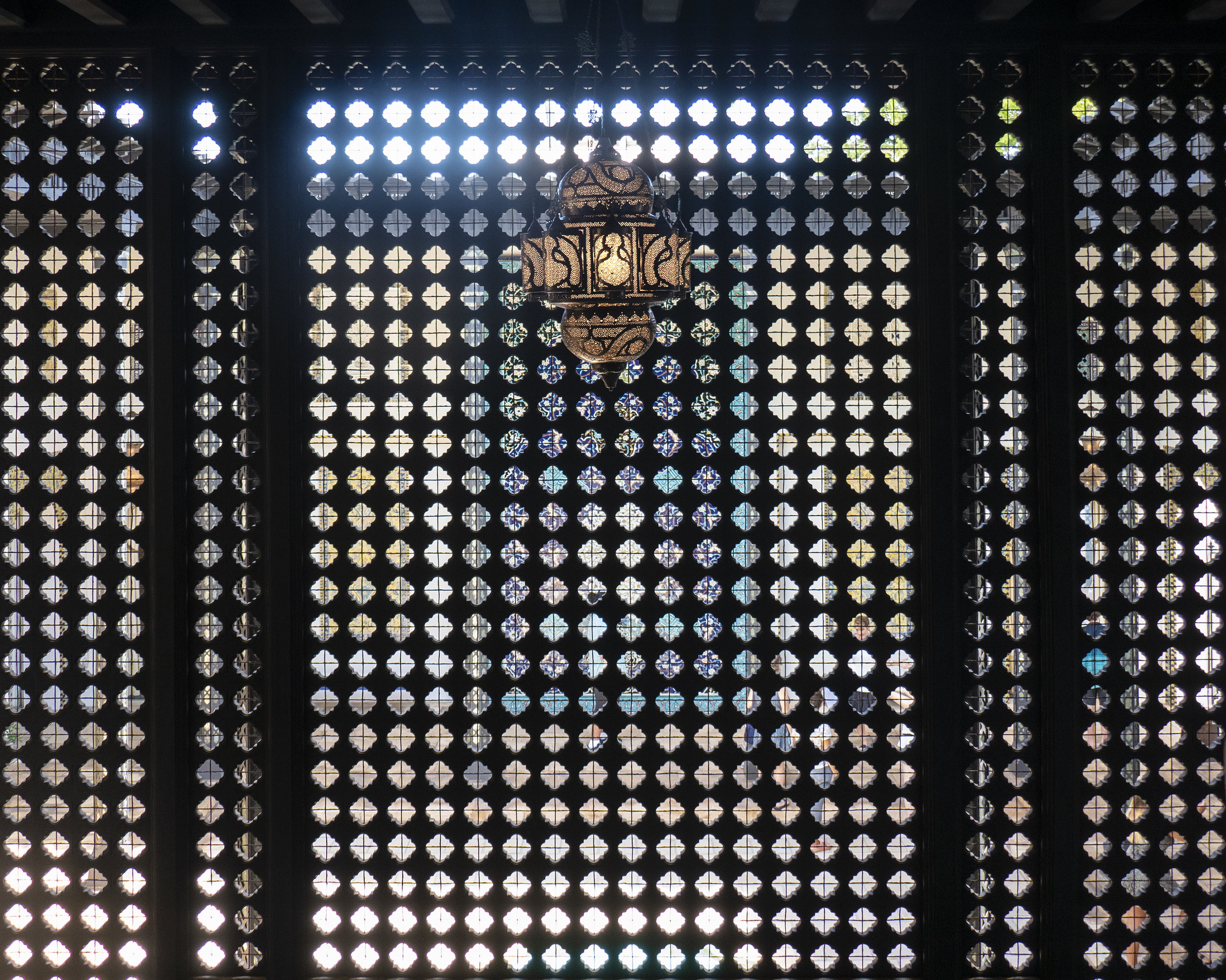
Duke had this wood carved screen made in Morocco in 1937; it separates the foyer from the central courtyard. Later you will see the large blue ceramic panel that is only seeping through the screen.
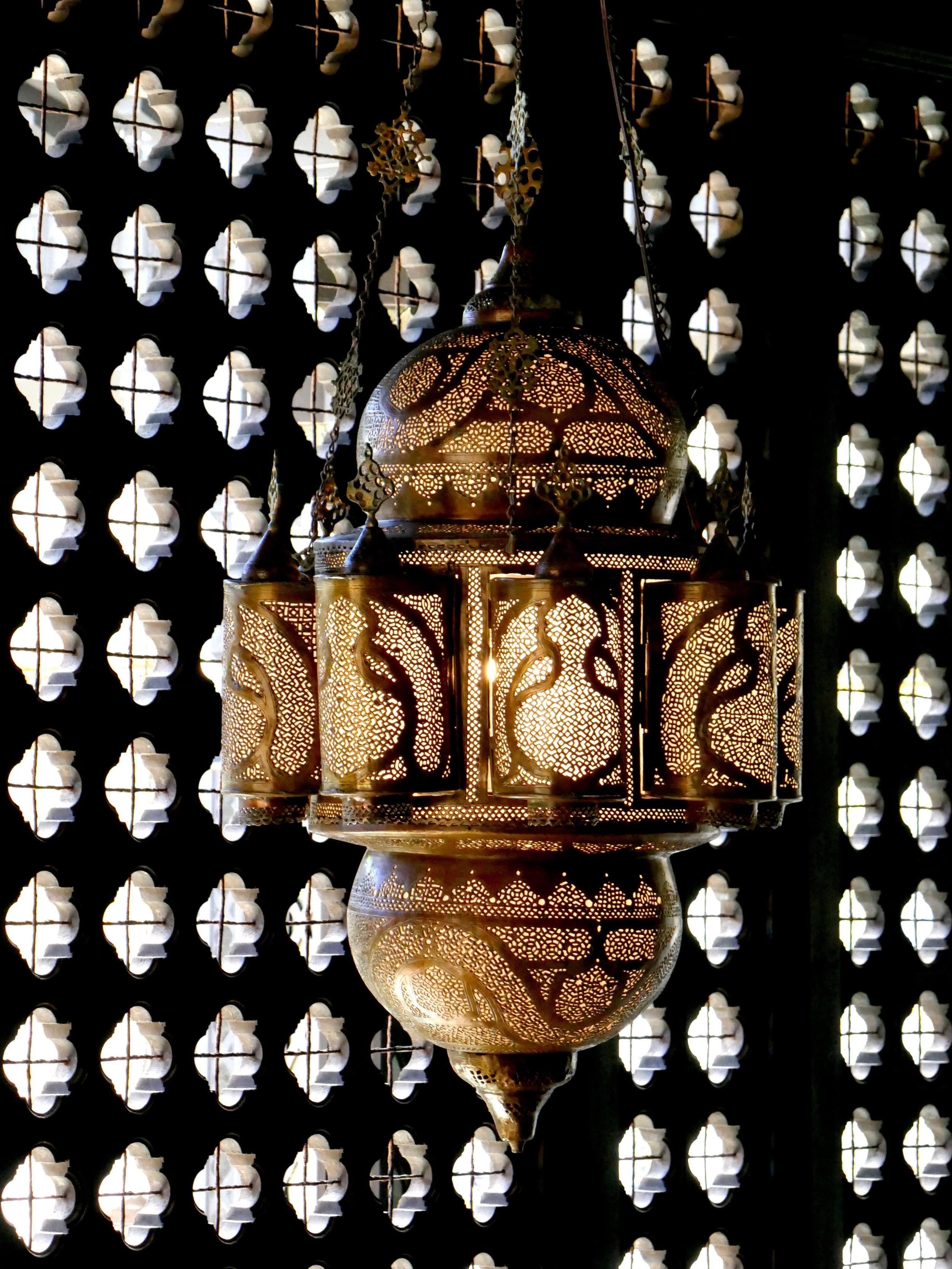
The Hanging Lamp was made from copper alloy in Egypt or Syria around 1900. The lamp itself is 48 inches long, with a diameter of 21.5 inches.
![A 19th c. Iran tile panel, "Princely Hunt Scene," made from stone-paste [a type of pottery in which frit (ground glass) is added to clay to reduce its fusion temperature] and polychrome glazes.](https://images.squarespace-cdn.com/content/v1/567de29d841abaa3c9152fbd/1564644135522-HYLUY978950AG7O8KONM/2019-7-25_P1110320_DD_Iran-Princely-Hunt-wall_sm.jpg)
A 19th c. Iran tile panel, "Princely Hunt Scene," made from stone-paste [a type of pottery in which frit (ground glass) is added to clay to reduce its fusion temperature] and polychrome glazes.
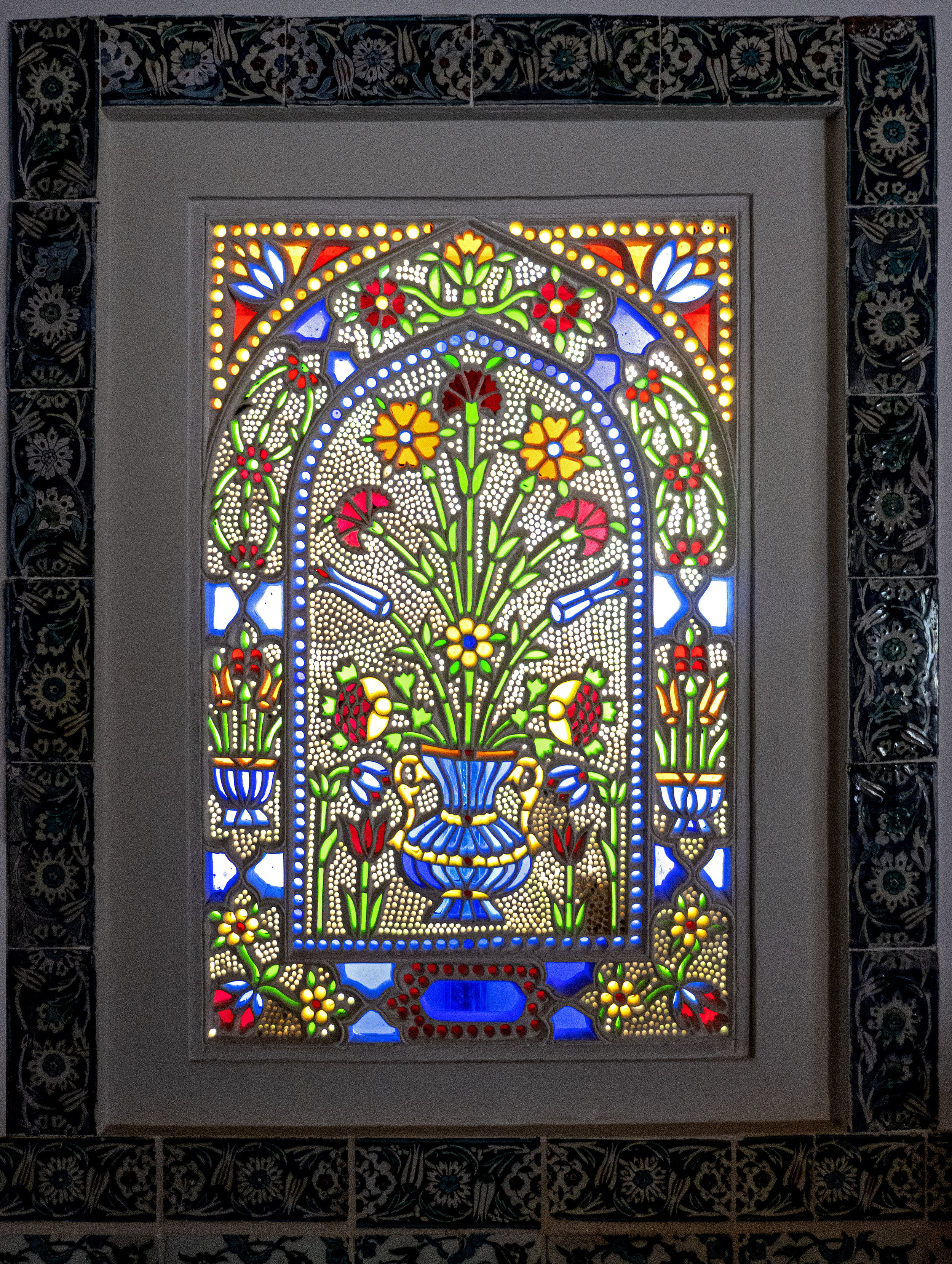
In the foyer, a 19th c. plaster and colored glass window from Egypt or Syria.
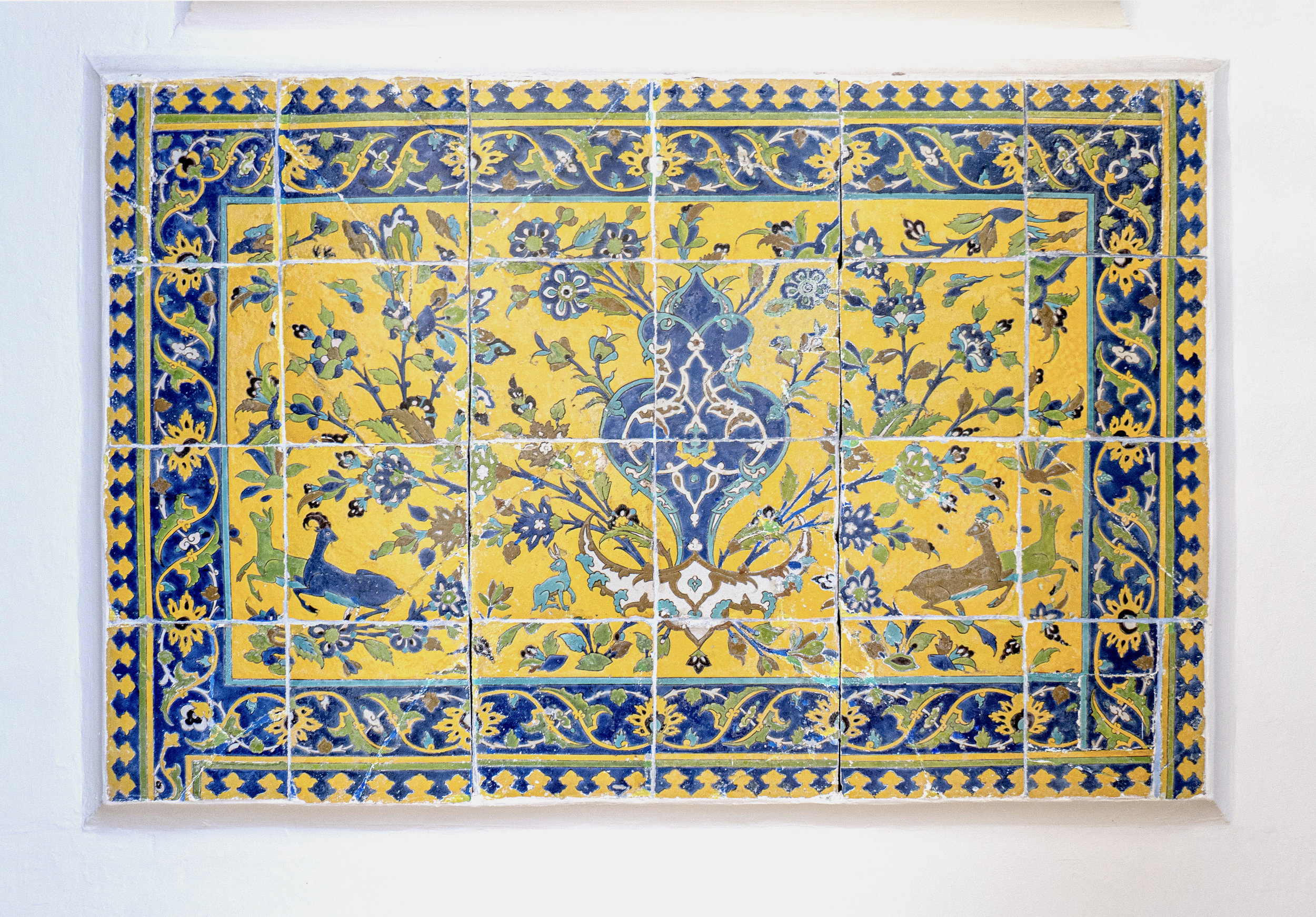
"Polychrome Tile Panel with Vase and Deer," 17th to 18th c. Iran, ceramic & colored glazes (36 3/4 x 55 1/2 in). "Mistakes" in repetitions may be intentional as only God can produce perfection.
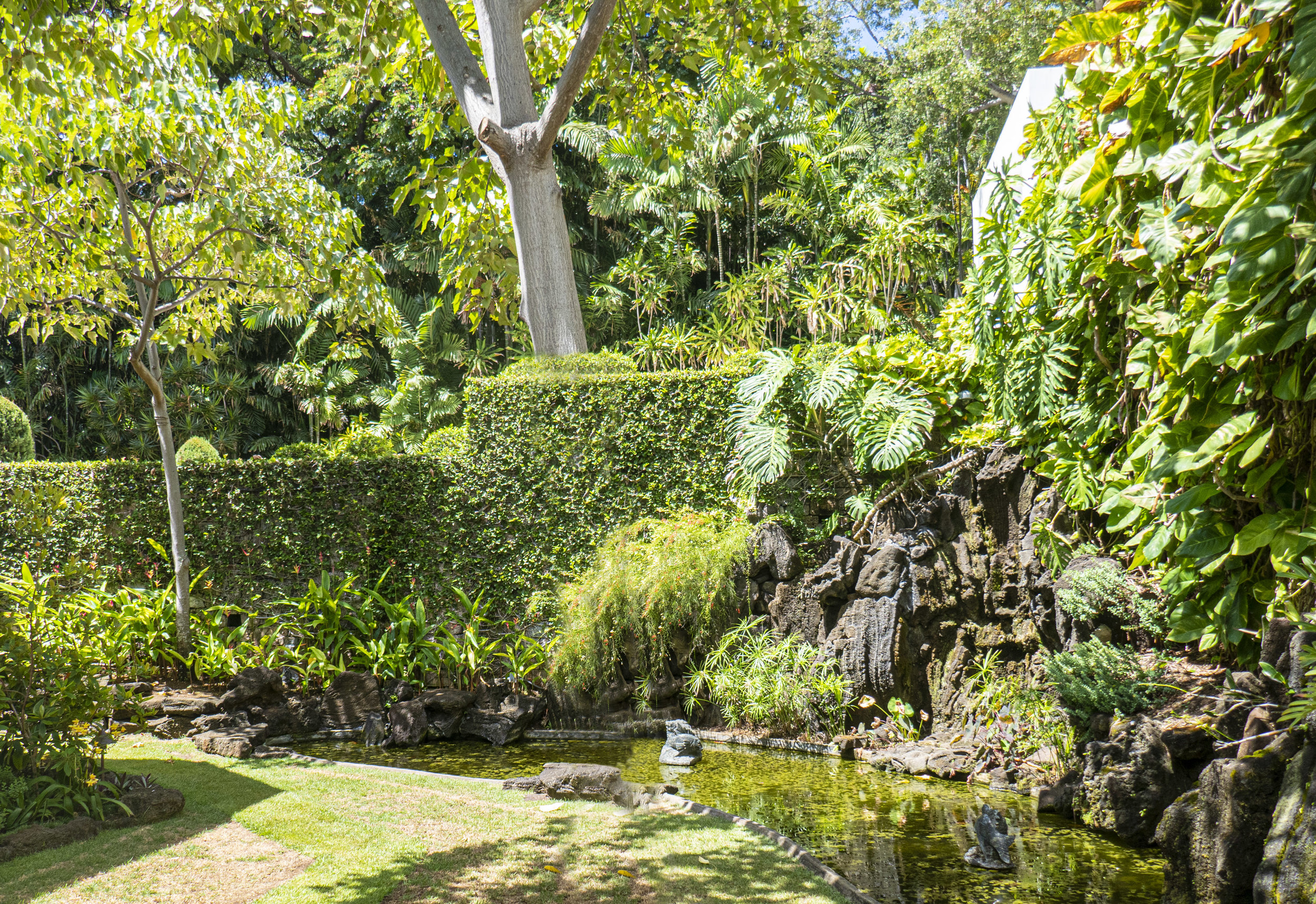
The inner hallway to Duke's bedroom includes a private lanai (porch) and a garden with a small waterfall and koi pond.
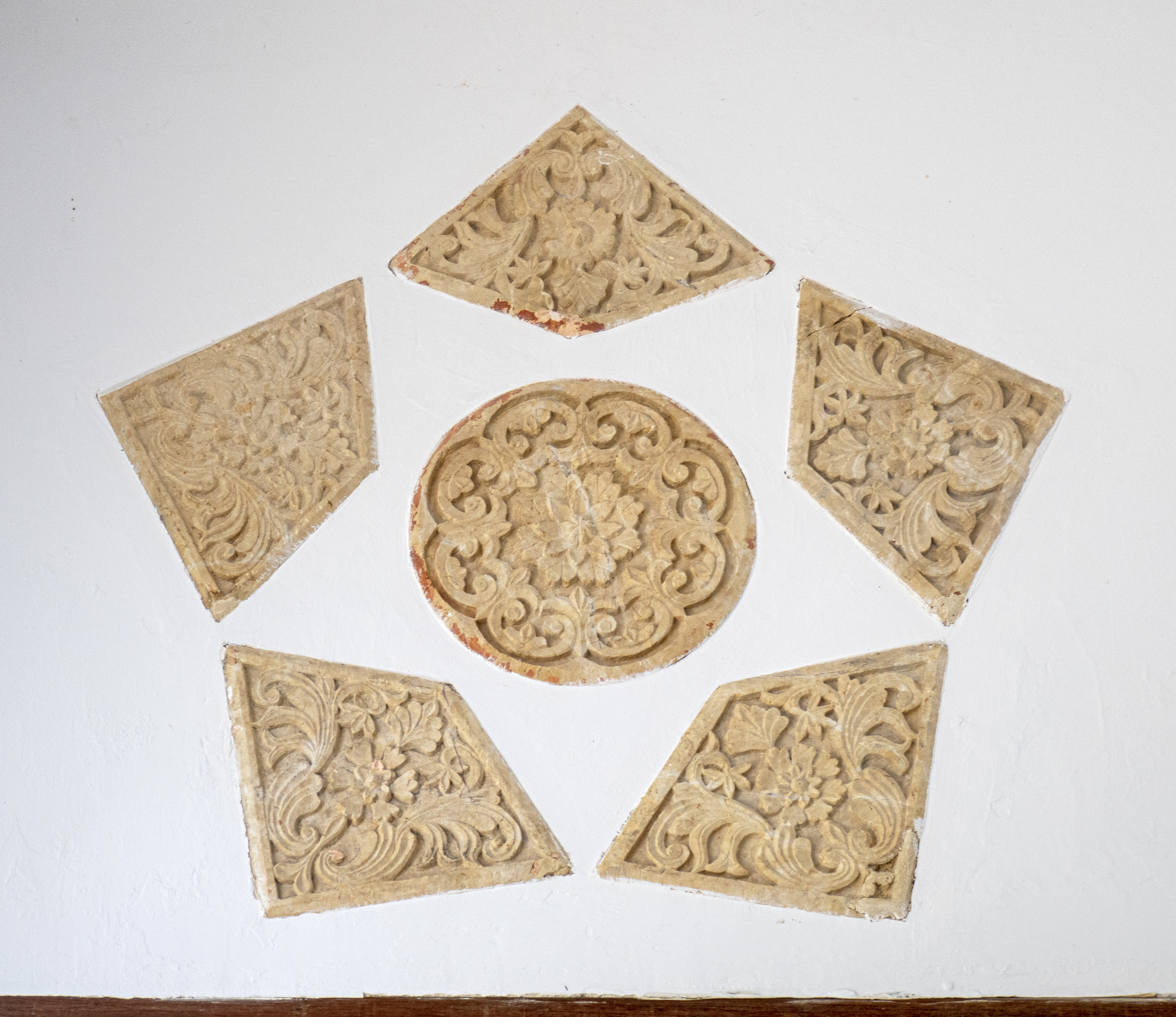
On the private lanai, a five point star (formed both in positive and negative space) made from stone, carved and painted in 18th to 19th century Syria (Damascus).
![Also in the lanai area, this 1921 tile panel from Spain reads: "Ave Maria Gracia Plena Dominus Tecum." ["Hail Mary, full of grace, the Lord is with thee." (I remembered from grade school!)]](https://images.squarespace-cdn.com/content/v1/567de29d841abaa3c9152fbd/1564644236807-EBG8DZMFBM4QI9Y1PR9A/2019-7-25_P1110326_DD_Ave-Maria-Tiles_sm.jpg)
Also in the lanai area, this 1921 tile panel from Spain reads: "Ave Maria Gracia Plena Dominus Tecum." ["Hail Mary, full of grace, the Lord is with thee." (I remembered from grade school!)]
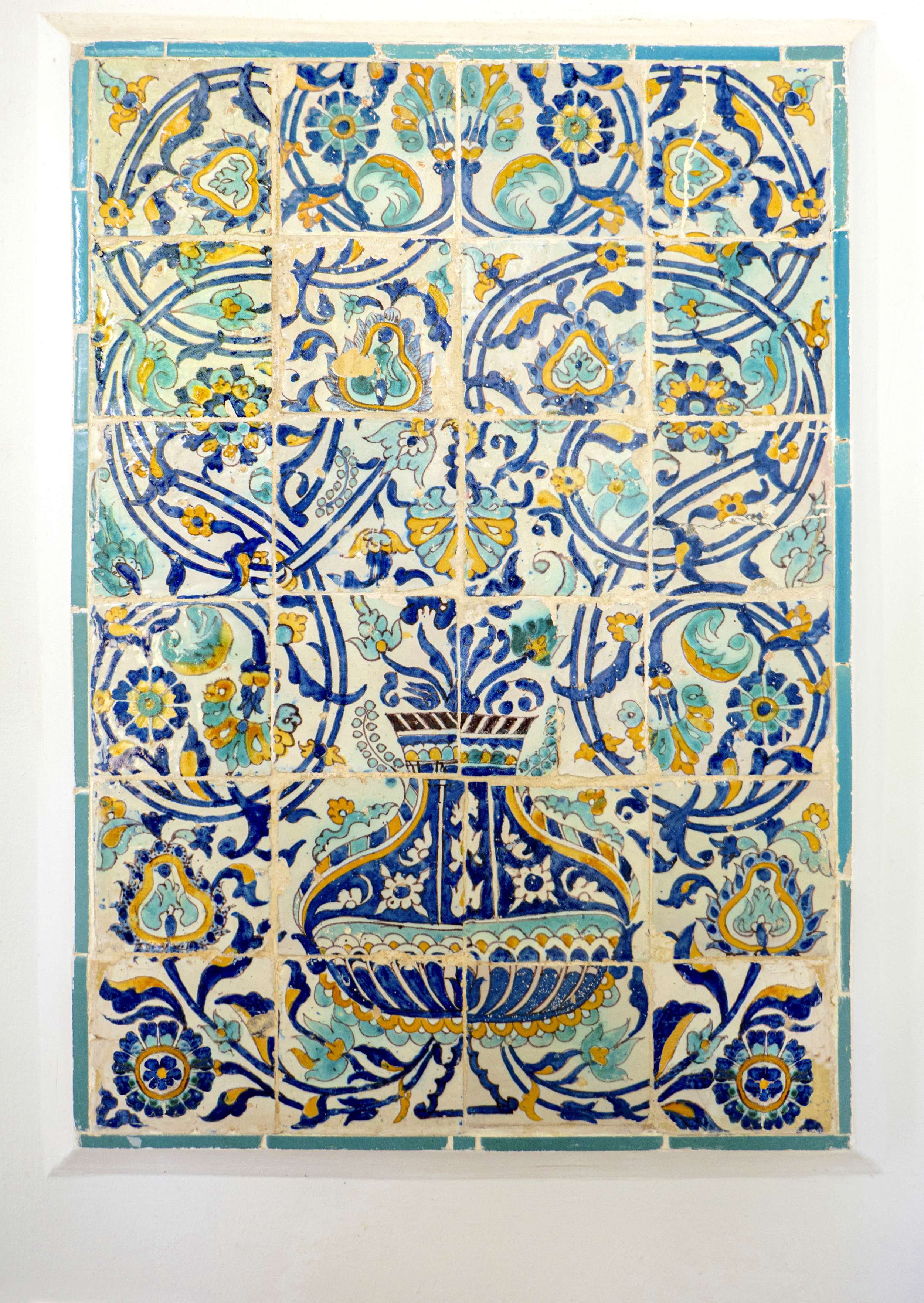
On the lanai, from Tunisia (once a part of the Ottoman Empire) this not quite symmetrical 19th c. "Tile Panel With Vase" made from earthenware and underglaze-painted. (Purposeful "mistakes"???)
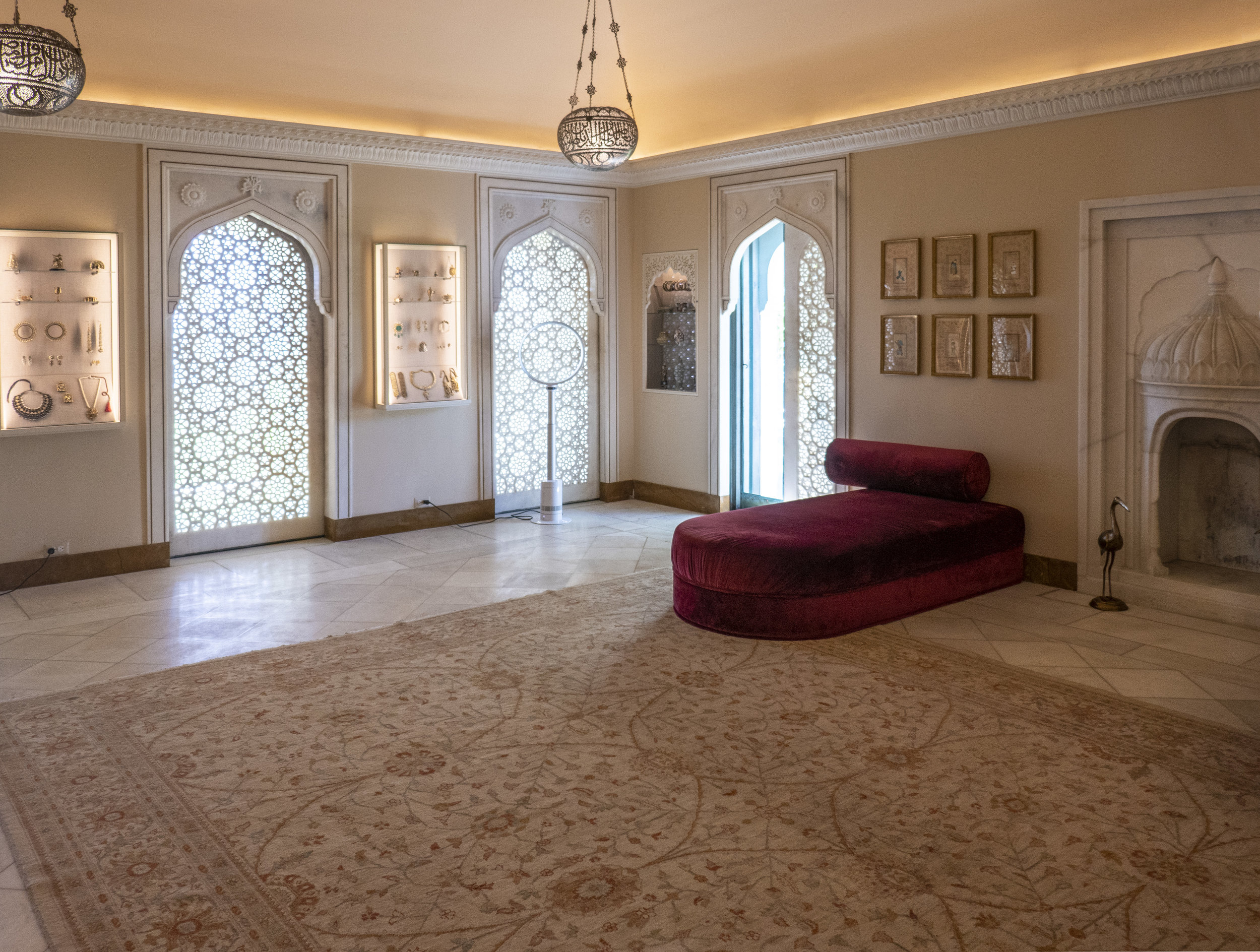
After visiting the marble tombs, palaces, mosques and gardens of cities like Agra and Delhi, Duke decided to create a Mughal-inspired bedroom suite for her home. It was completed in late 1938.

Seven large door jalis (perforated marble screens) for the bedroom were made by India Marble Works, Agra, India. The jali can slide open or shut to provide varying degrees of light, air, and privacy.
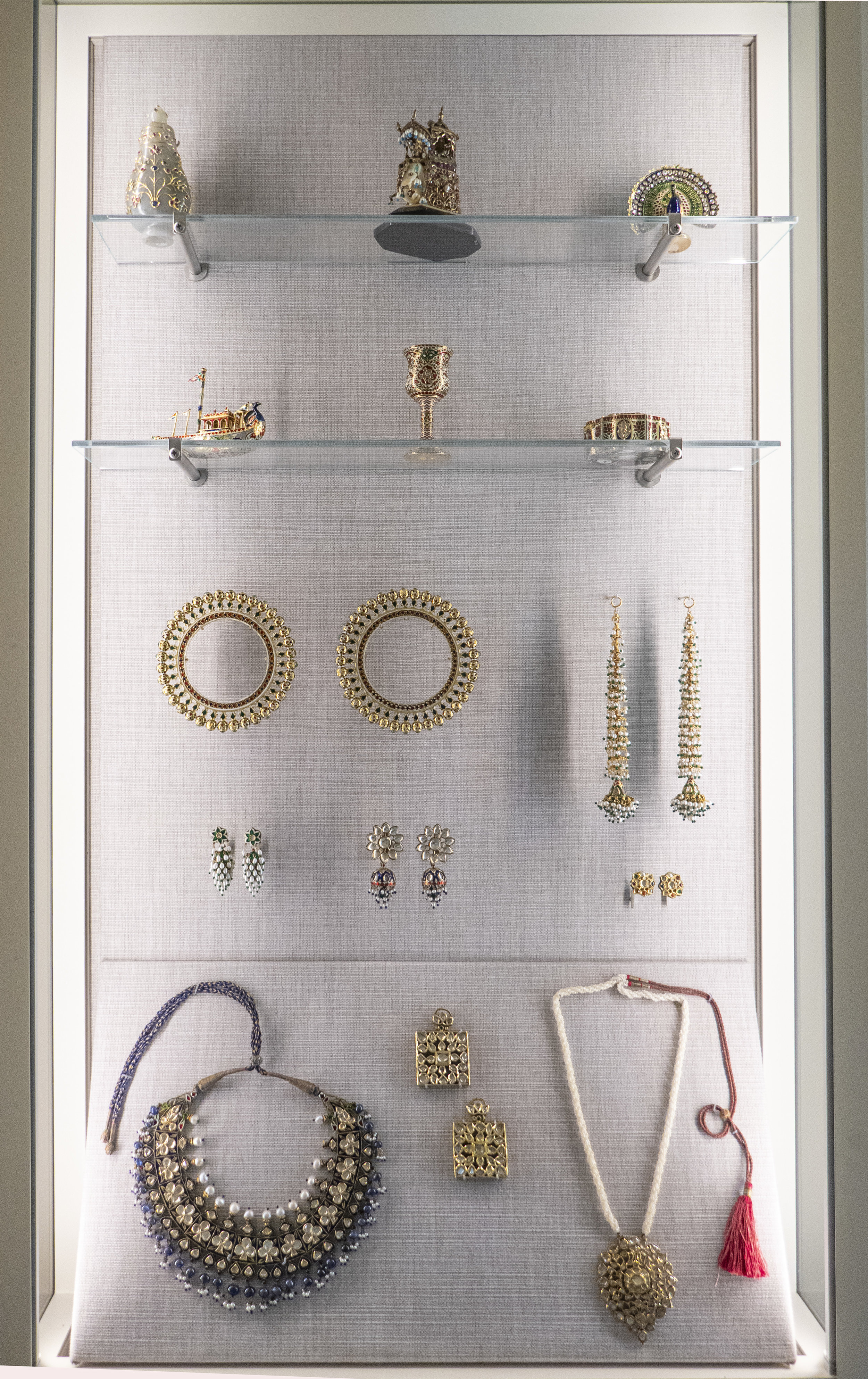
One of two jewelry wall vitrines in the Mughal bedroom suite.
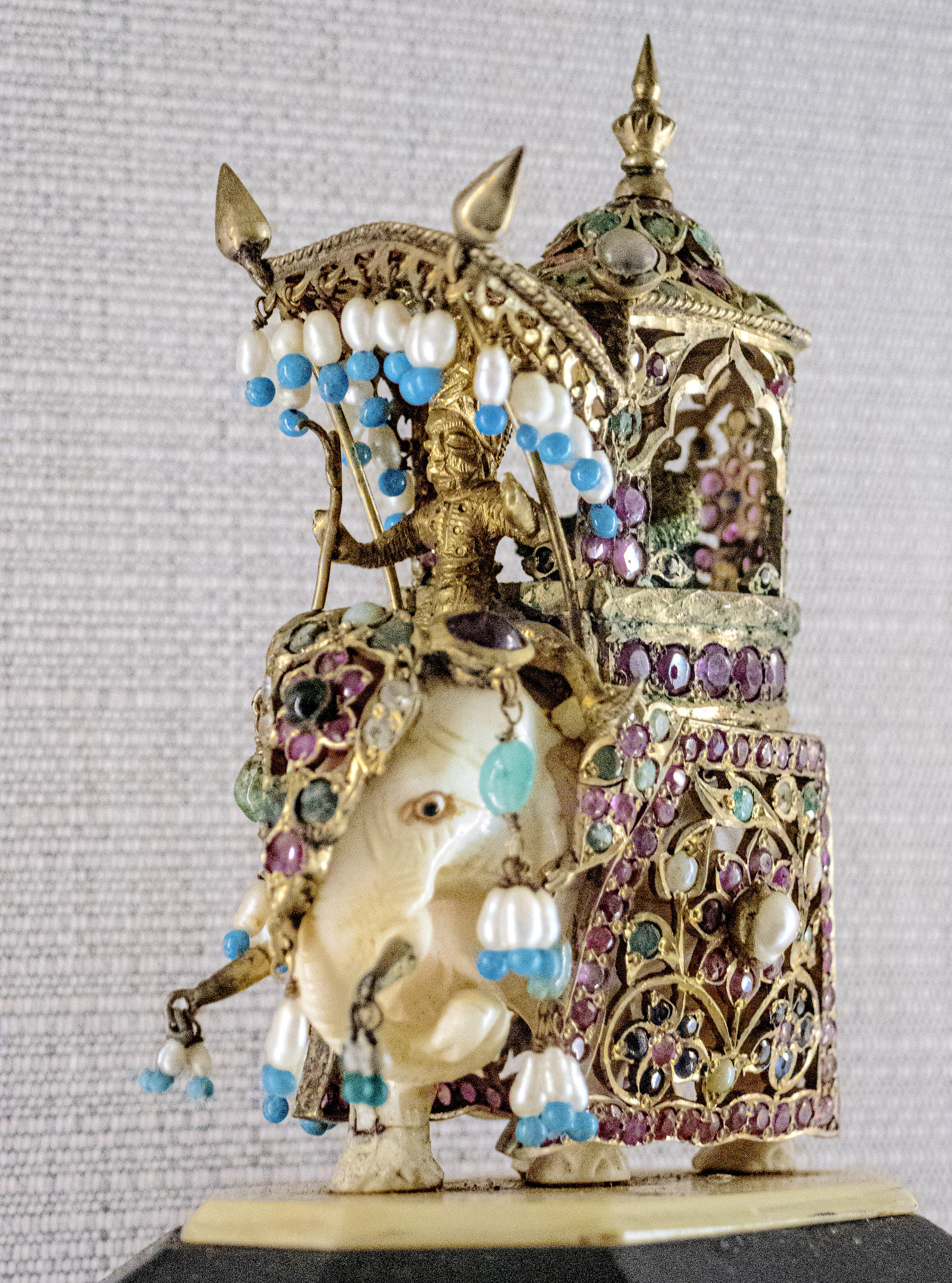
Made in India during the 19th - 20th century this jewell encrusted hathi howdah measures 4 x 2 3/8 x 3 3/8 inches and is made of ivory, gold, seed pearls, glass pendants, hardstones, with a wood base.

The peacock on the top shelf of the vitrine was made of enameled gold and gemstones in 19th c. Northern India and measures 2/5/8 x 2 1/16 x 2 7/8 inches.
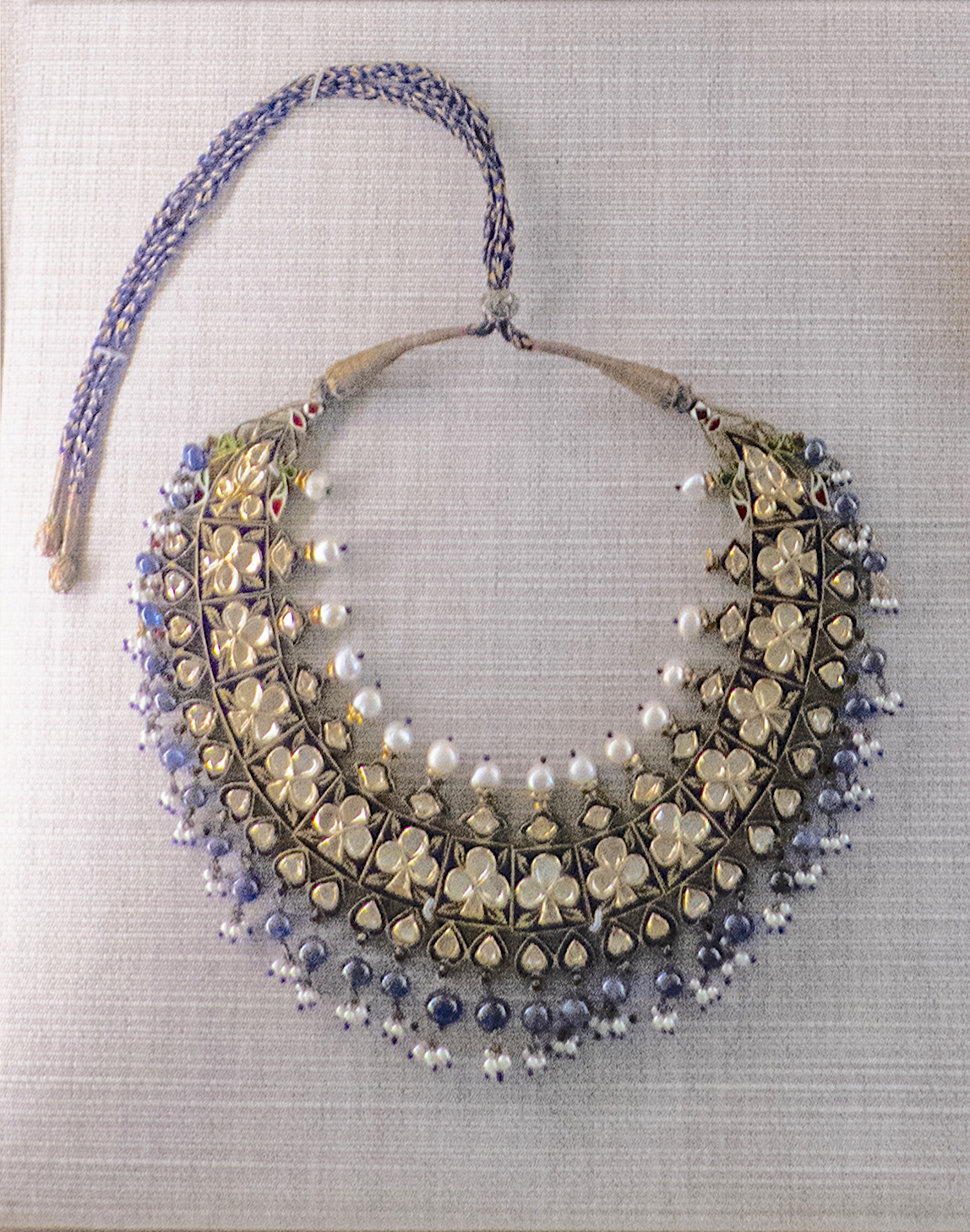
The 19th c. Indian necklace is made of enameled gold, diamonds, sapphire beads, pearls, seed pearls, blue glass beads, with Quatrefoil Motifs and Enamelled (Kundun) Floral Ornamentation on Reverse.

Also in the vitrine, these 19th-20th c. India "Gold-Set Pearl and Emerald Chandelier Earrings," height: 6 3/4 in., with enameled gold, seed pearls, glass beads, diamonds, and cord.

In 1966 Doris Duke shows a necklace for readers of Vogue (internet pic). This necklace is seen on the bottom row (middle) of the other wall vitrine in the Mughal bedroom suite (see next picture).
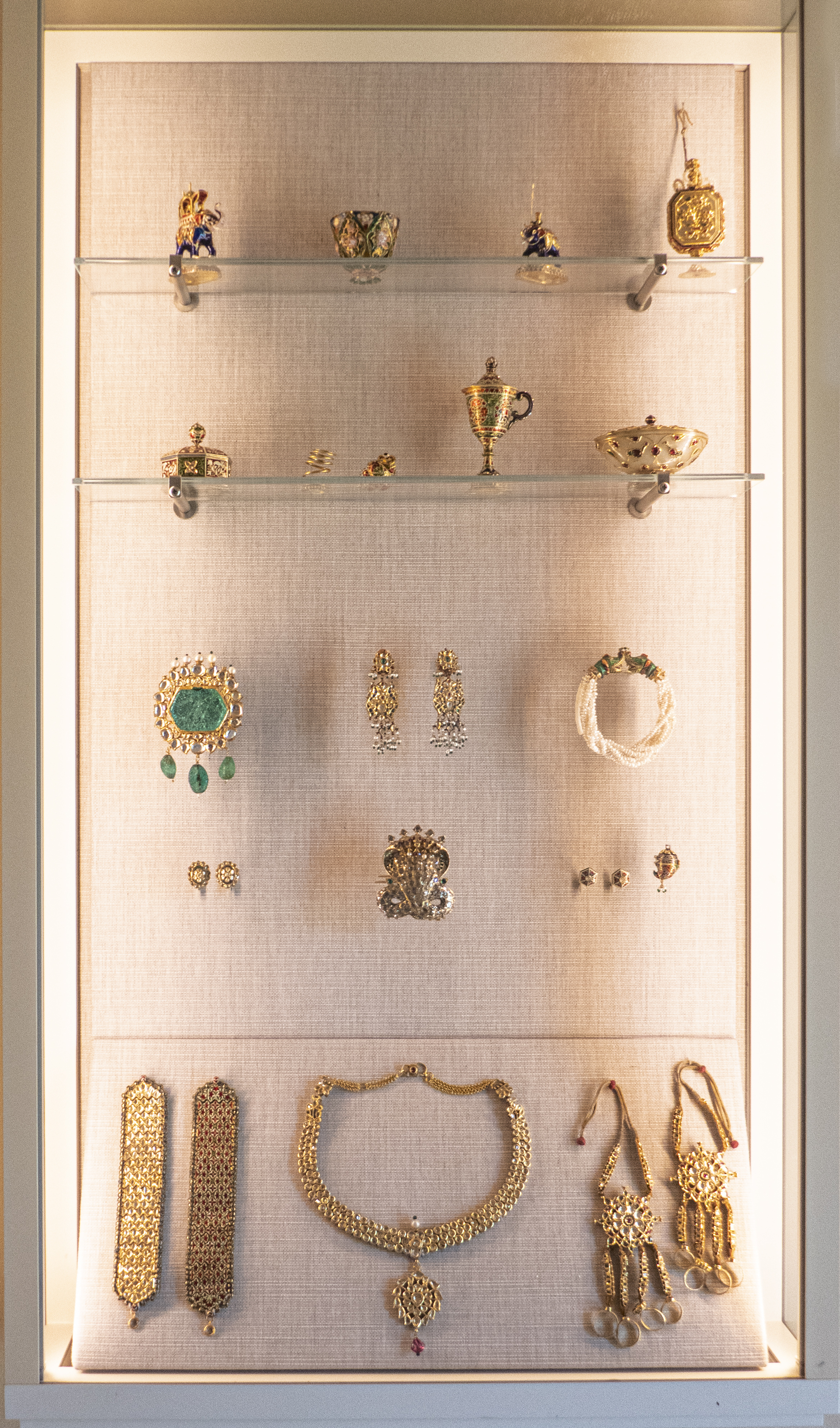
A second jewelry vitrine in the Mughal bedroom suite. Bottom row, middle contains the necklace that Duke was showing in 1966 to the photographer from Vogue in the previous picture.

In 1935, Doris Duke and James Cromwell on their honeymoon in India riding an elephant. Perhaps that is one reason the two vitrines contain jewell encrusted elephants.

"Elephant with Driver and Rider in the Hathi Howdah" was made of enameled gold and diamonds in the 19th to 20th c. in Northern India and stands 2 3/4 x 1 /18 x 2 3/16 in.
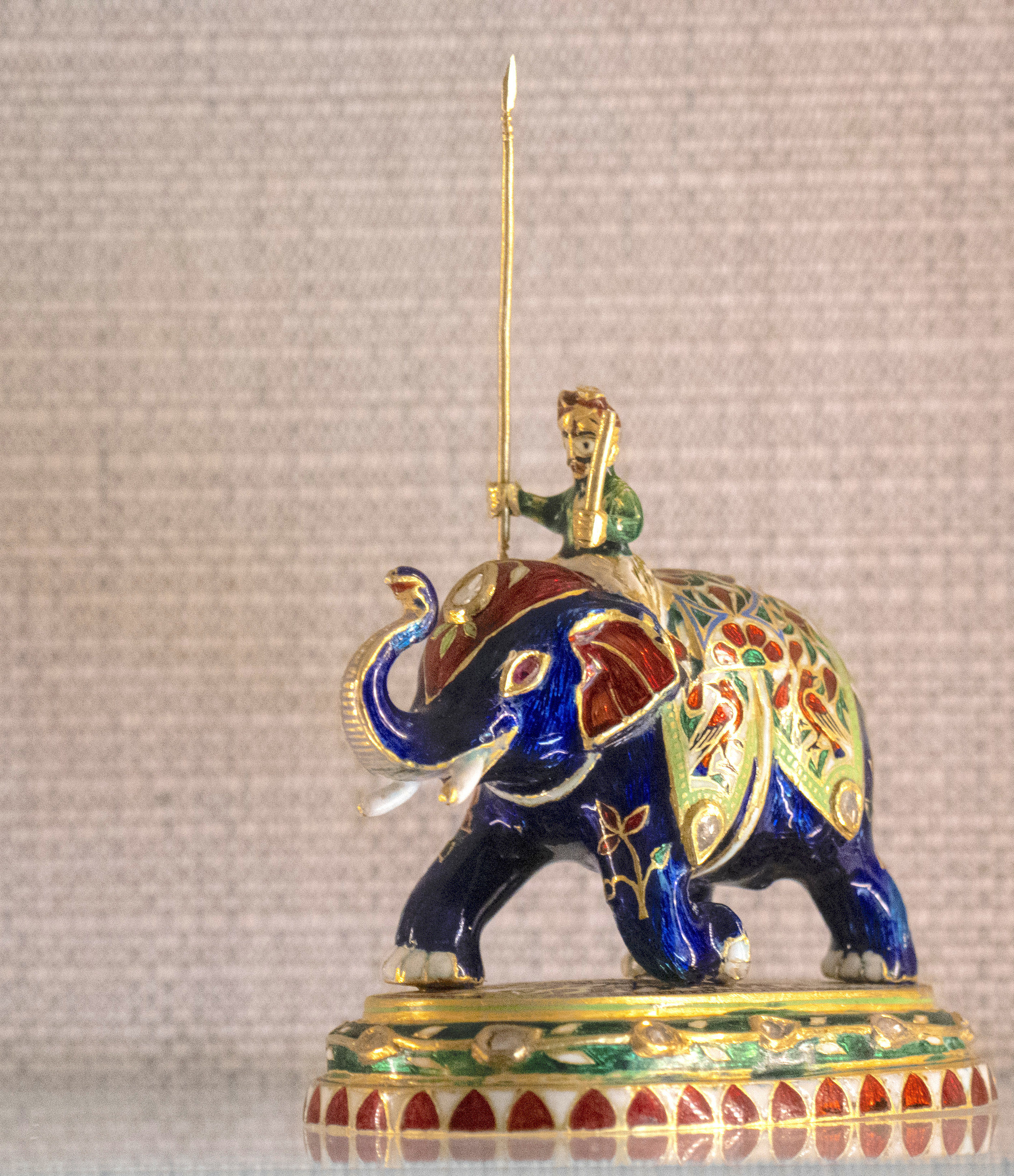
"Hunter with Spear on Elephant" was made of enameled gold and diamonds in the 19th to 20th c. in Northern India and stands 1 3/4 x 1 3/16 x 1 7/8 inches.
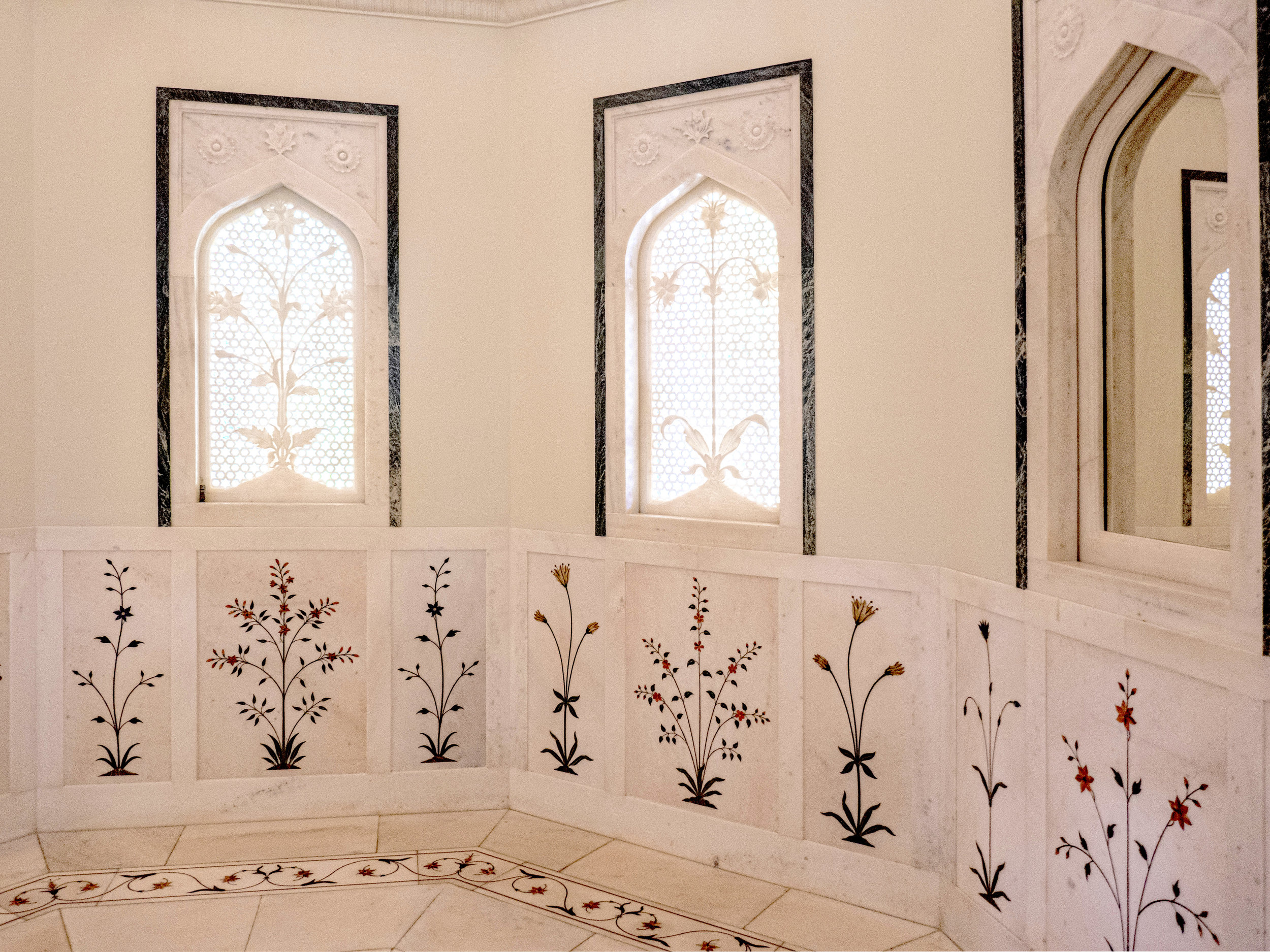
As part of the 1935 commission, India Marble Works, Agra made four small window jalis and a dado (lower wall) with inlaid floral patterns (called "pietra dura") for the Mughal Suite bathroom.
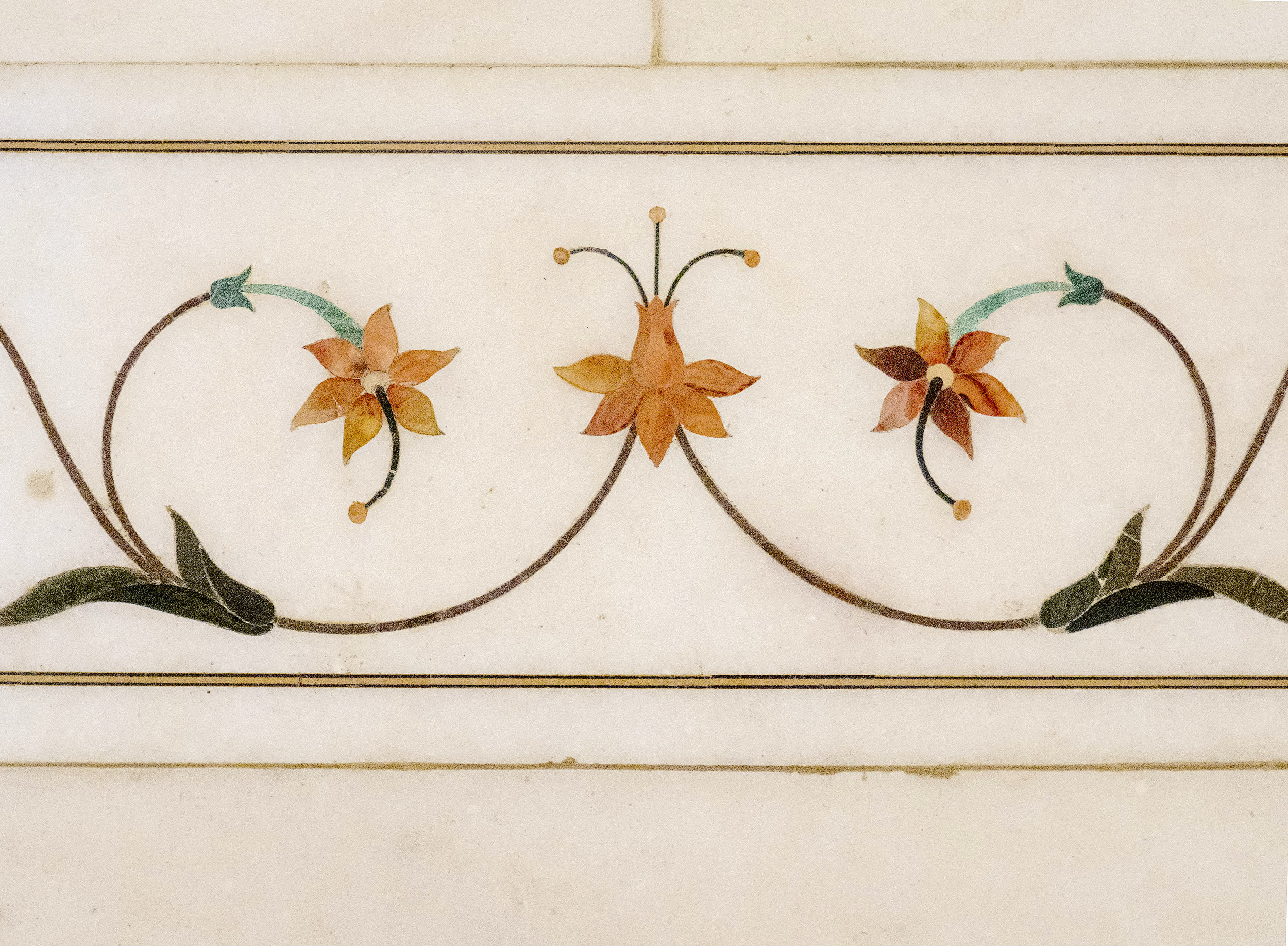
From the ancient Roman opus sectile, 14th to 17th c. Florentine artisans developed "pietra dura" ("hard stone"), the technique of creating intricate inlaid pictures from shaped colored stones.
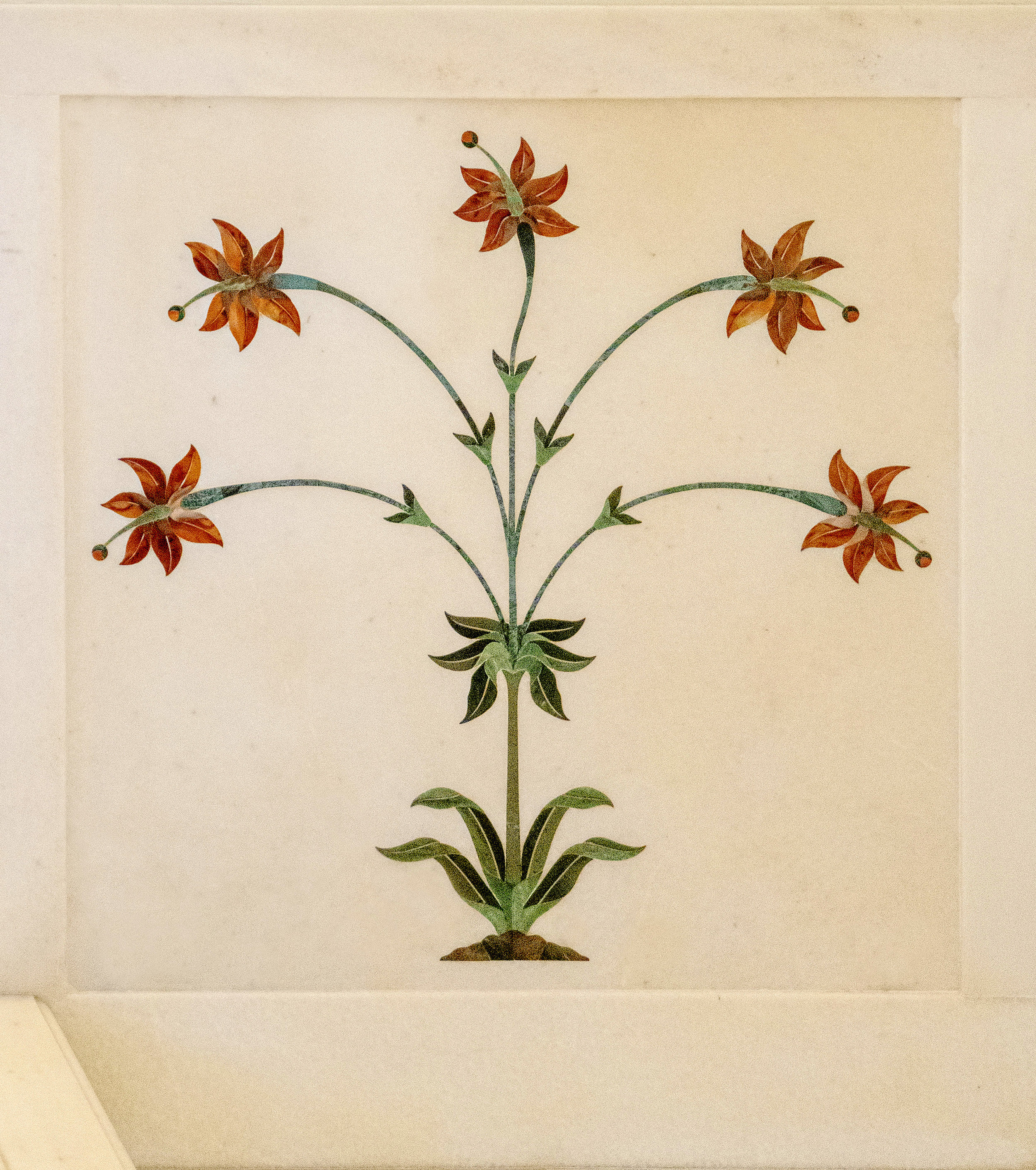
By the early 17th c. small objects produced by the Florentine artisans were widely diffused throughout Europe, and as far East to the court of the Mughals in India, and thereby viewed by Shah Jahan.
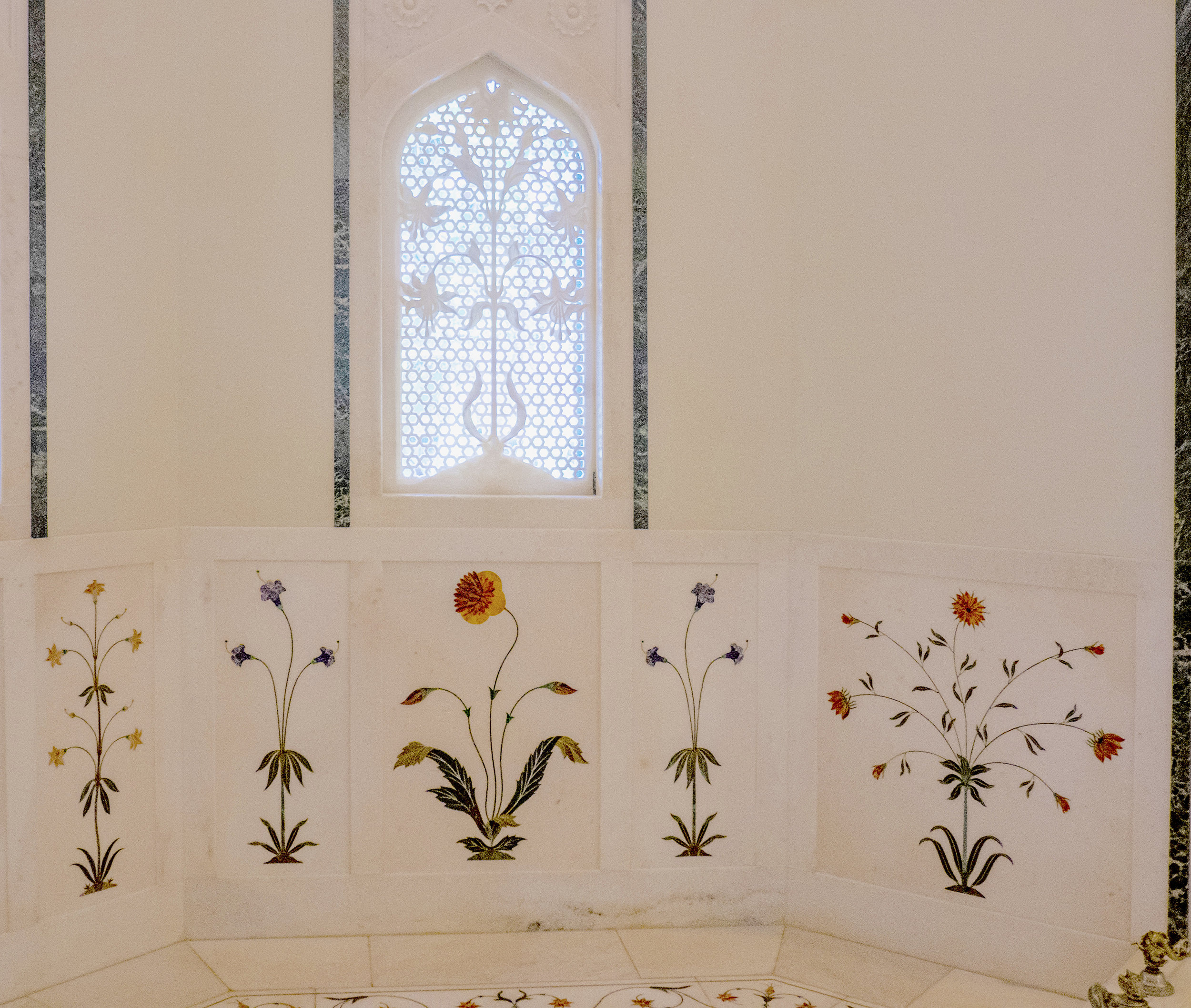
Each jail is carved with a different floral design. Like Shah Jahan's Taj Mahal itself, Duke’s white marble suite was inlaid with semiprecious stones, including lapis lazuli, jade, and malachite.
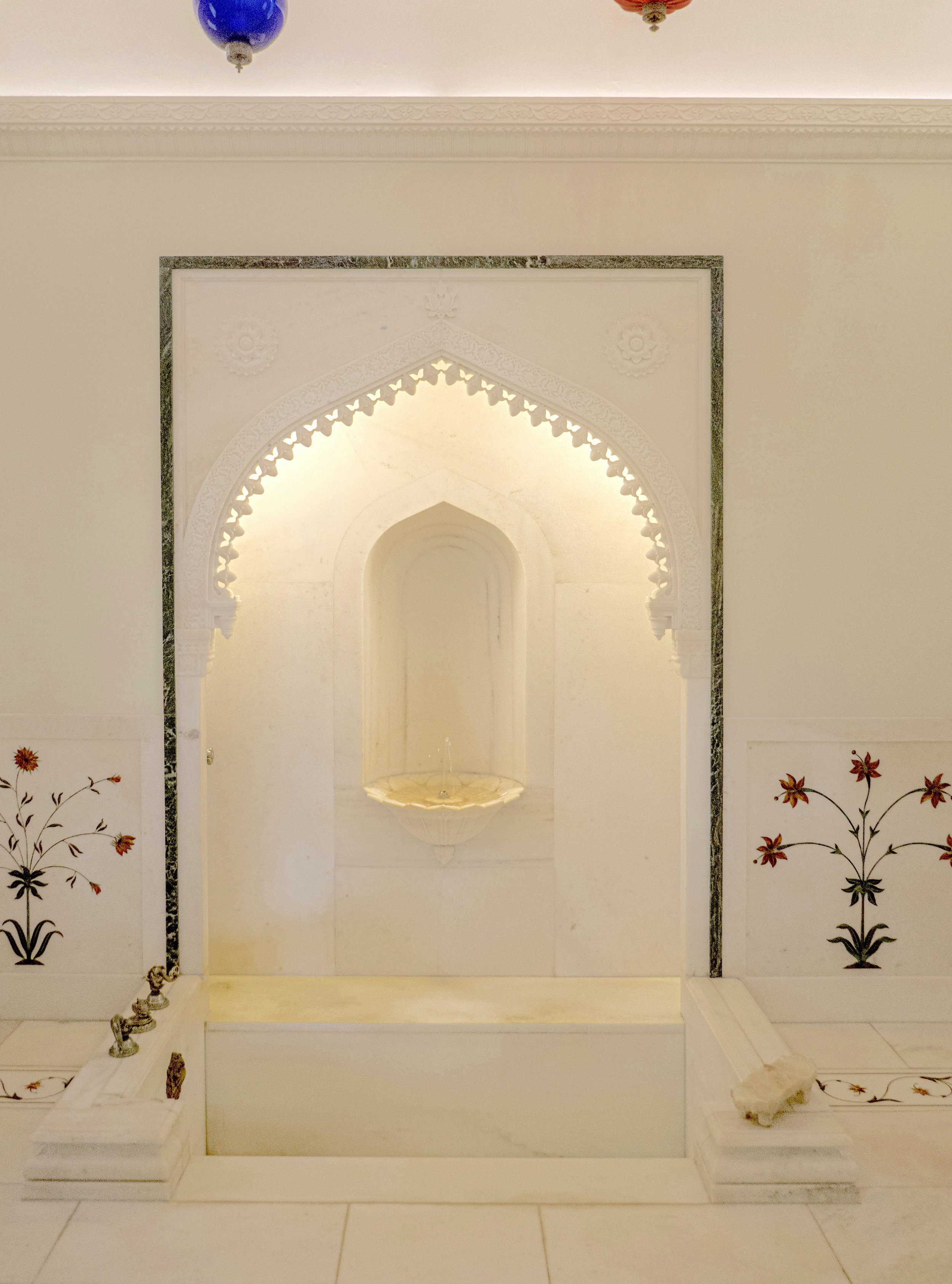
A carved marble arch frames a lotus-shaped wall basin and a deep rectangular bathtub below. It is surrounded by pieta dura floral designs in marble.
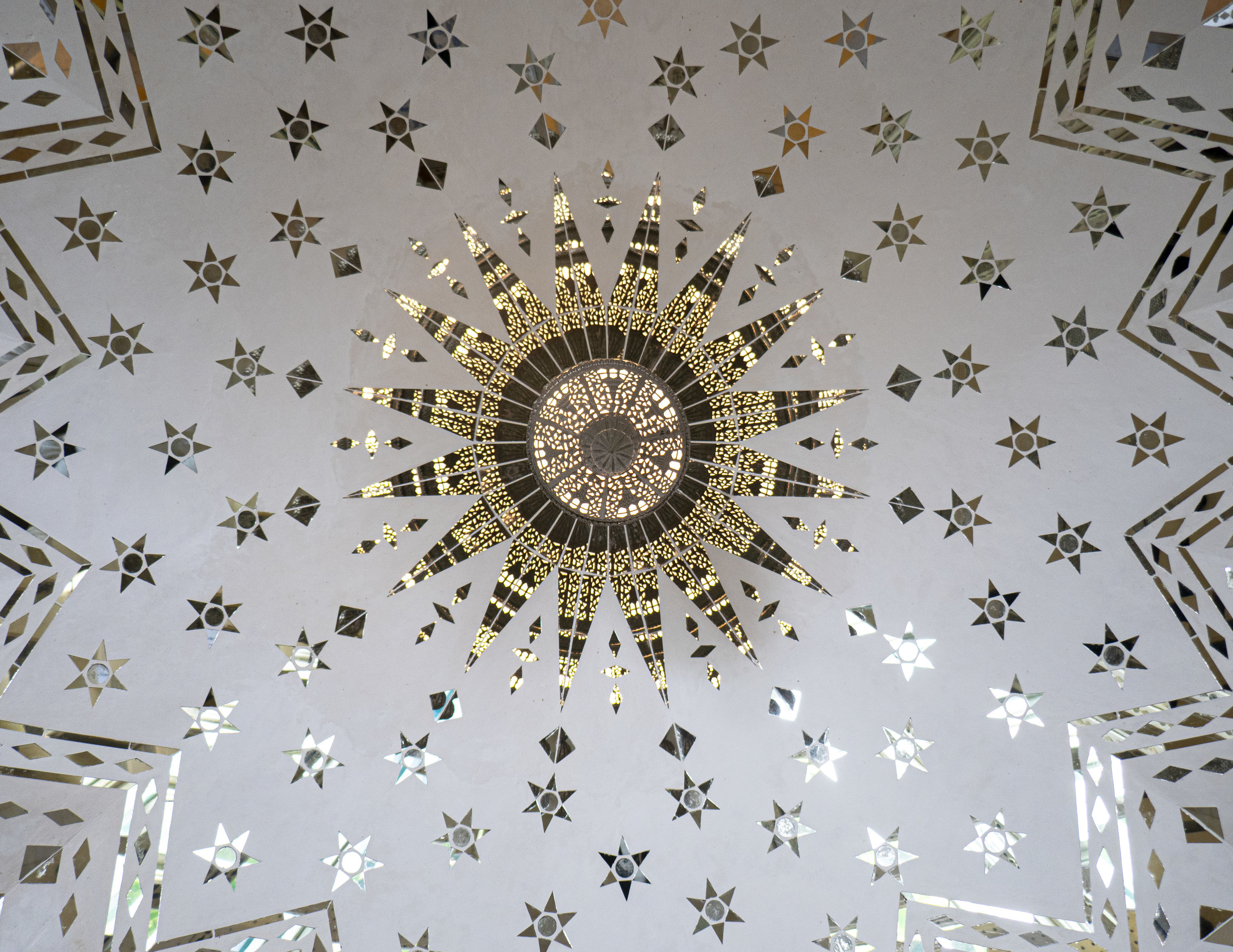
Like the Shish Mahal in the Agra Fort built by Shah Jahan between 1631-40 that Duke visited during her 1935 honeymoon, the ceiling of her Mughal Suite bathroom contains mirrors to reflect the light.

Shangri La is designed around this central courtyard fronted by public spaces such as the living room, Turkish Rooms, and pool.

In the courtyard, a 19th to early 20th c. Iranian tile mosaic panel in a cartouche form depicting a black and white spotted leopard at left attacking a brown deer at right on a turquoise background.

From 13th c. Iran, "Cobalt Blue and Turquoise Glazed Tile Panel with Molded and Bossed Decoration." Above the tile, is the Moroccan wood screen that was described earlier as part of the foyer.
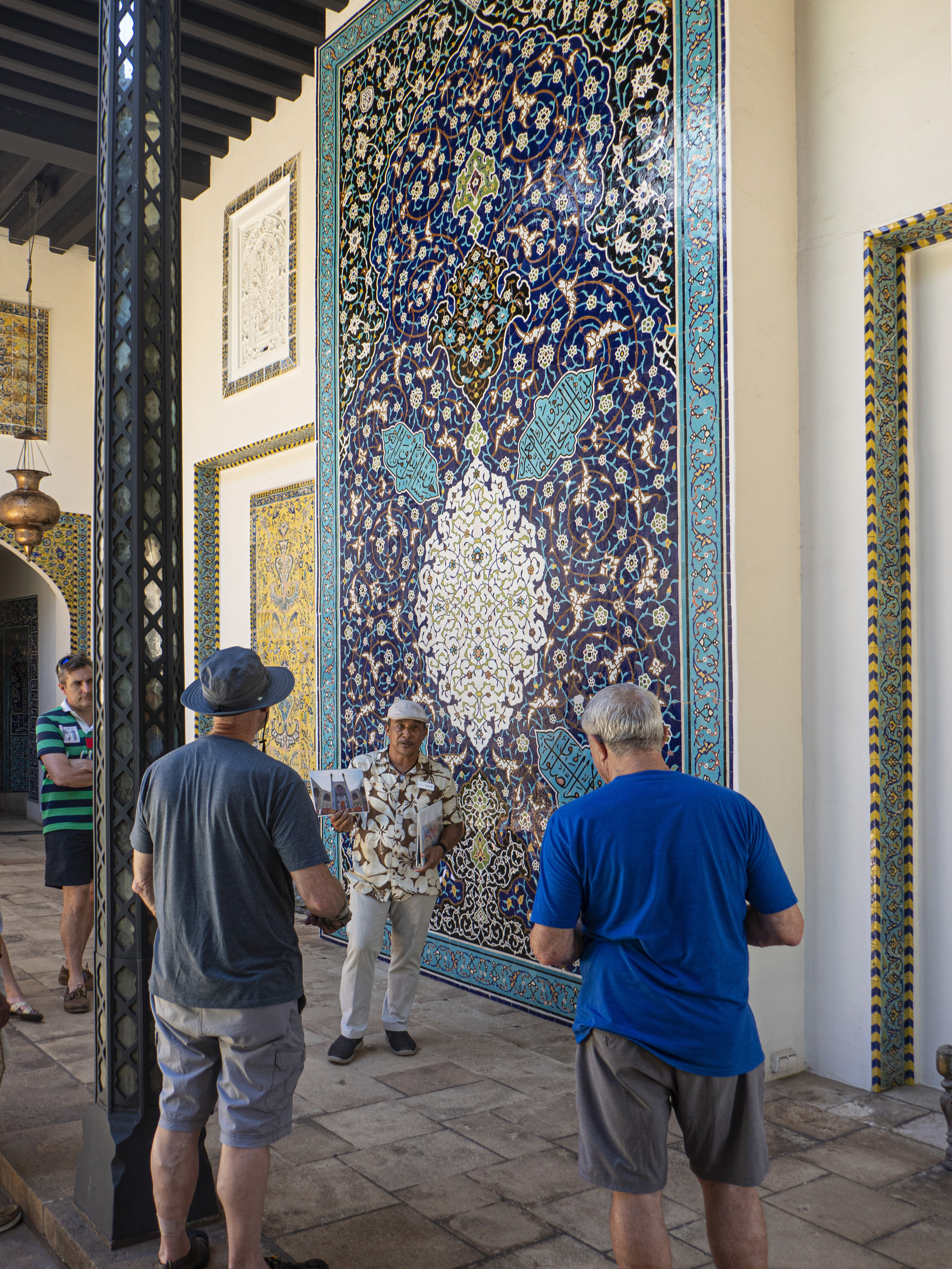
This "Polychrome Cut-Mosaic Tile Panel," which we glimpsed through the screen while on the foyer, measures 20 ft. x 11 ft. and was custom-made for Shangri La in Iran in 1938.
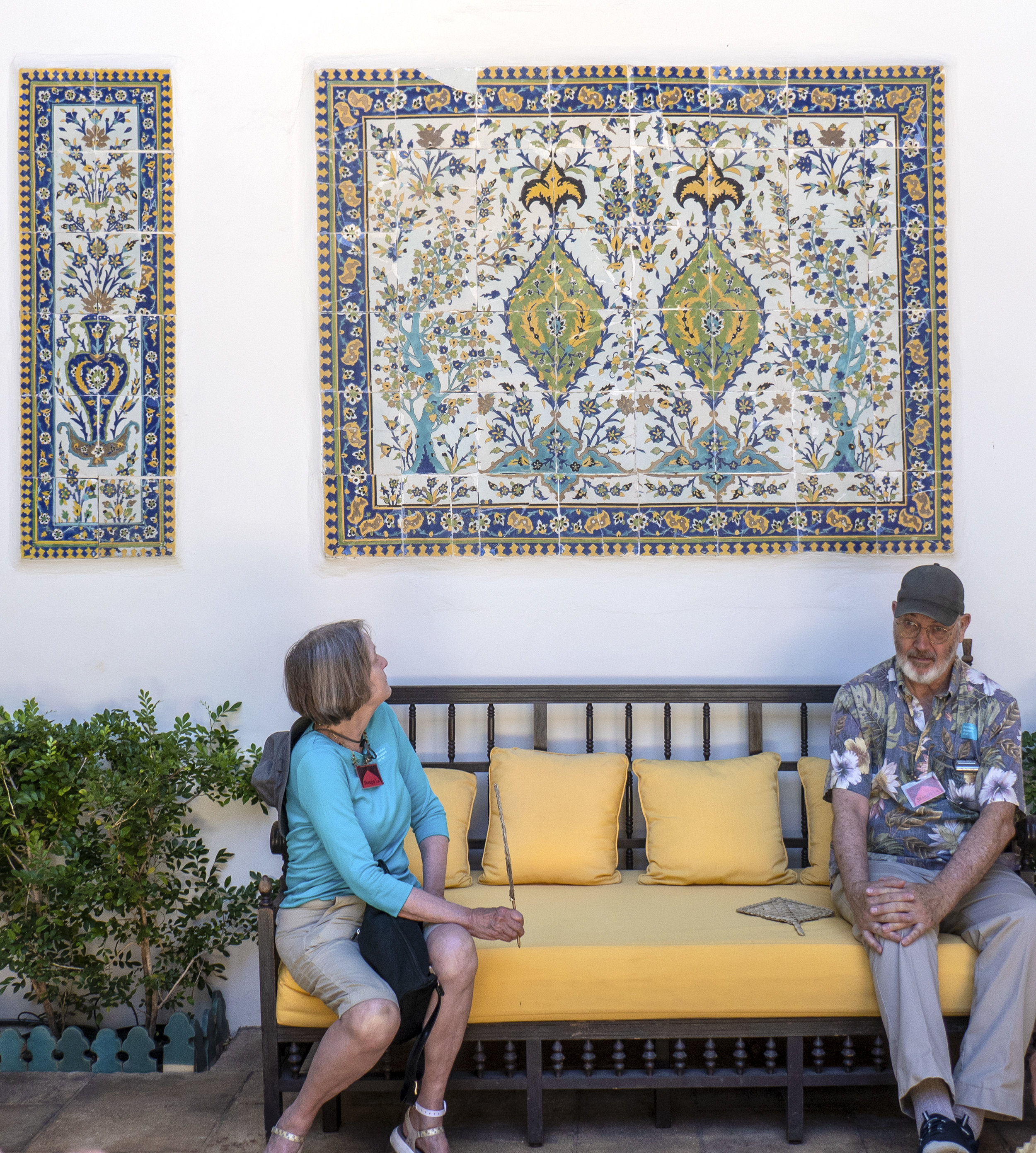
"Polychrome Tile Panel with Medallions and Trees" - As is evident from this intricately designed 17th c. Iranian ceramic tile panel, things did not always get to Hawai'i in one piece.
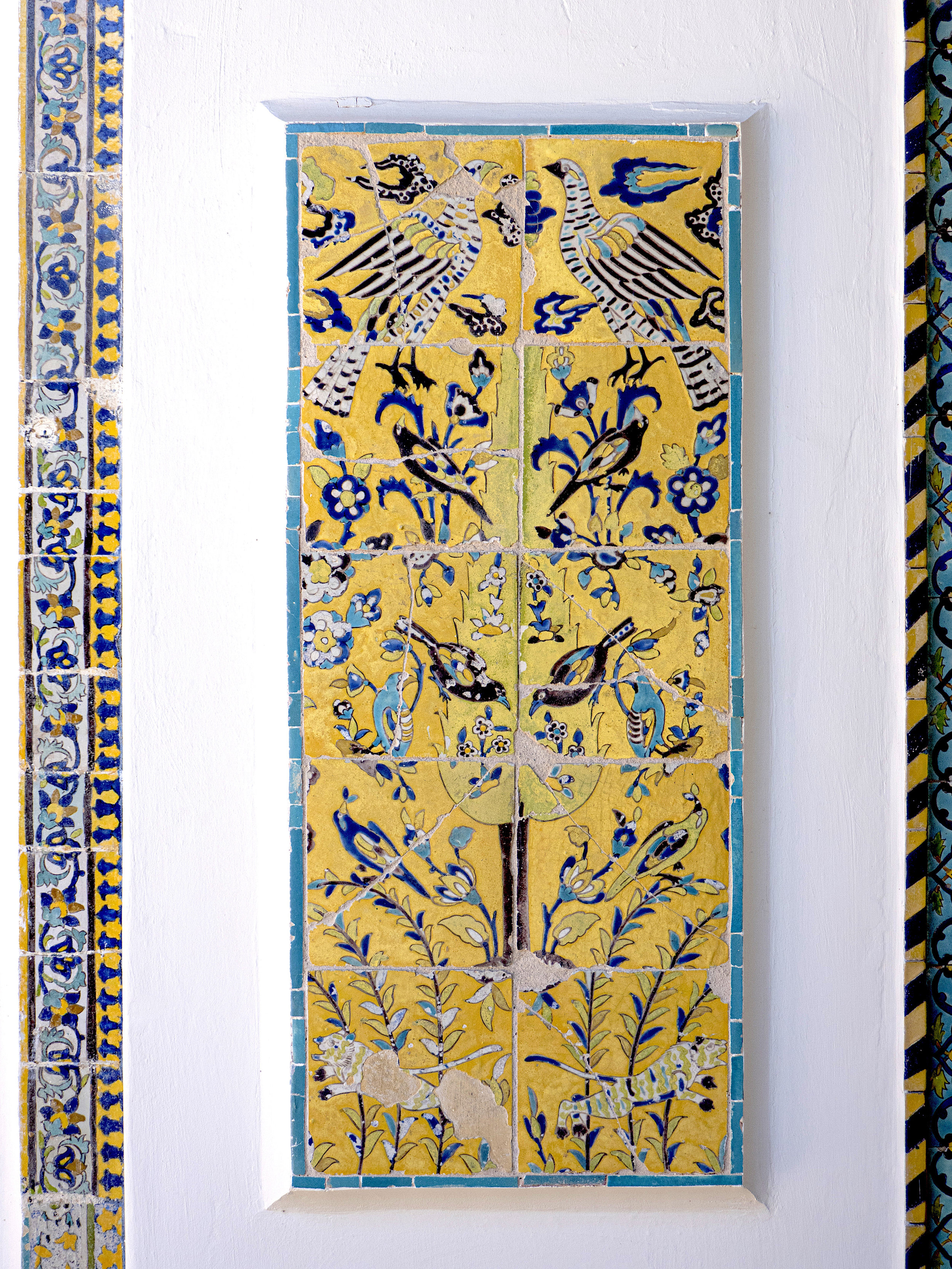
"Tile Panel with Birds, Flowers, and Leopards," Iran, 17th c. measures 45 3/4 x 19 1/8 in. In the Qur'an 16:79, the mysterious ability of birds to fly is offered as proof of God's existence.
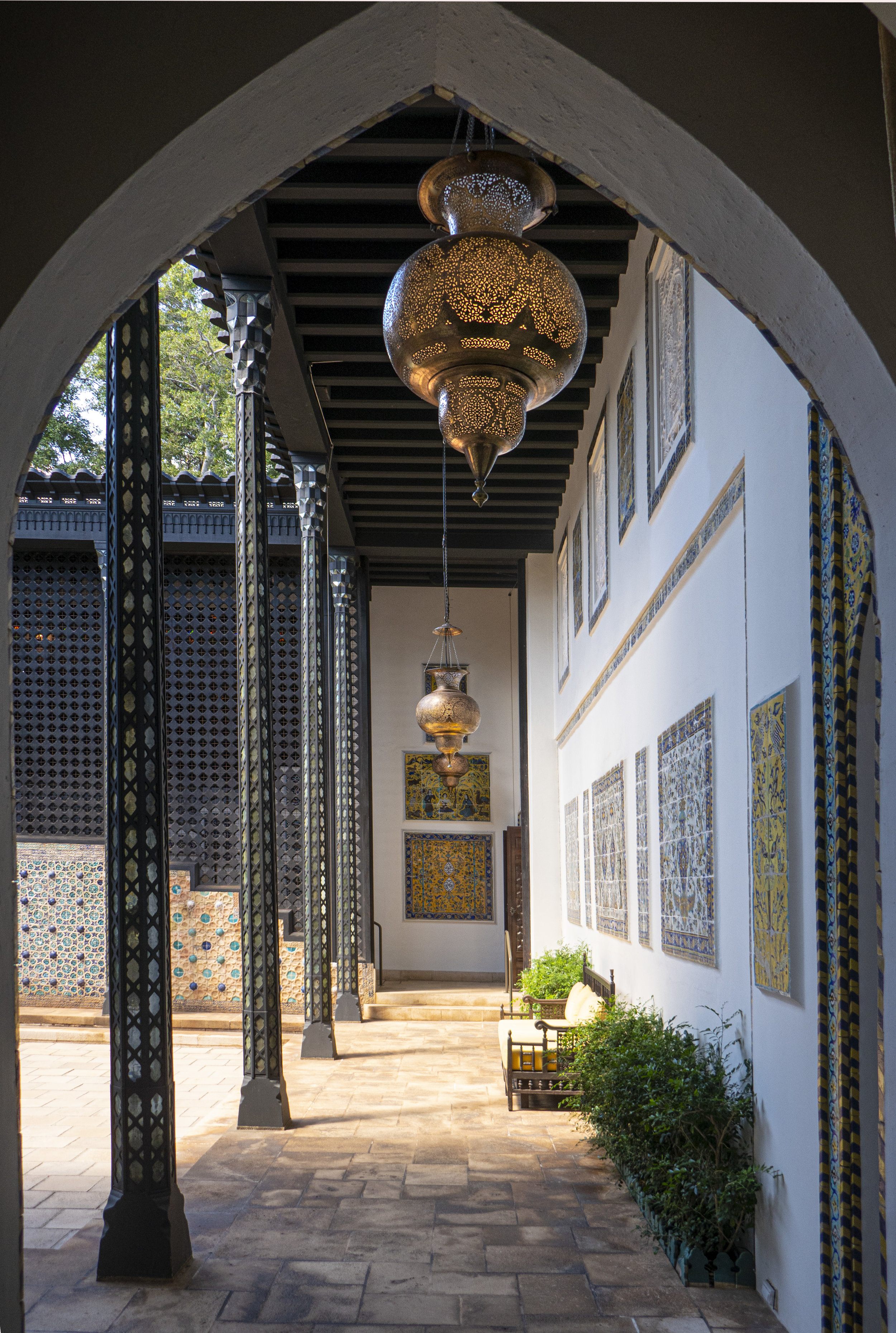
In 1937, Duke had a set of 12 columns, made for Shangri La's central courtyard (inspired by Safavid Persian models) by a company in Chicago. The columns were made of wood, pigments, and mirrors.
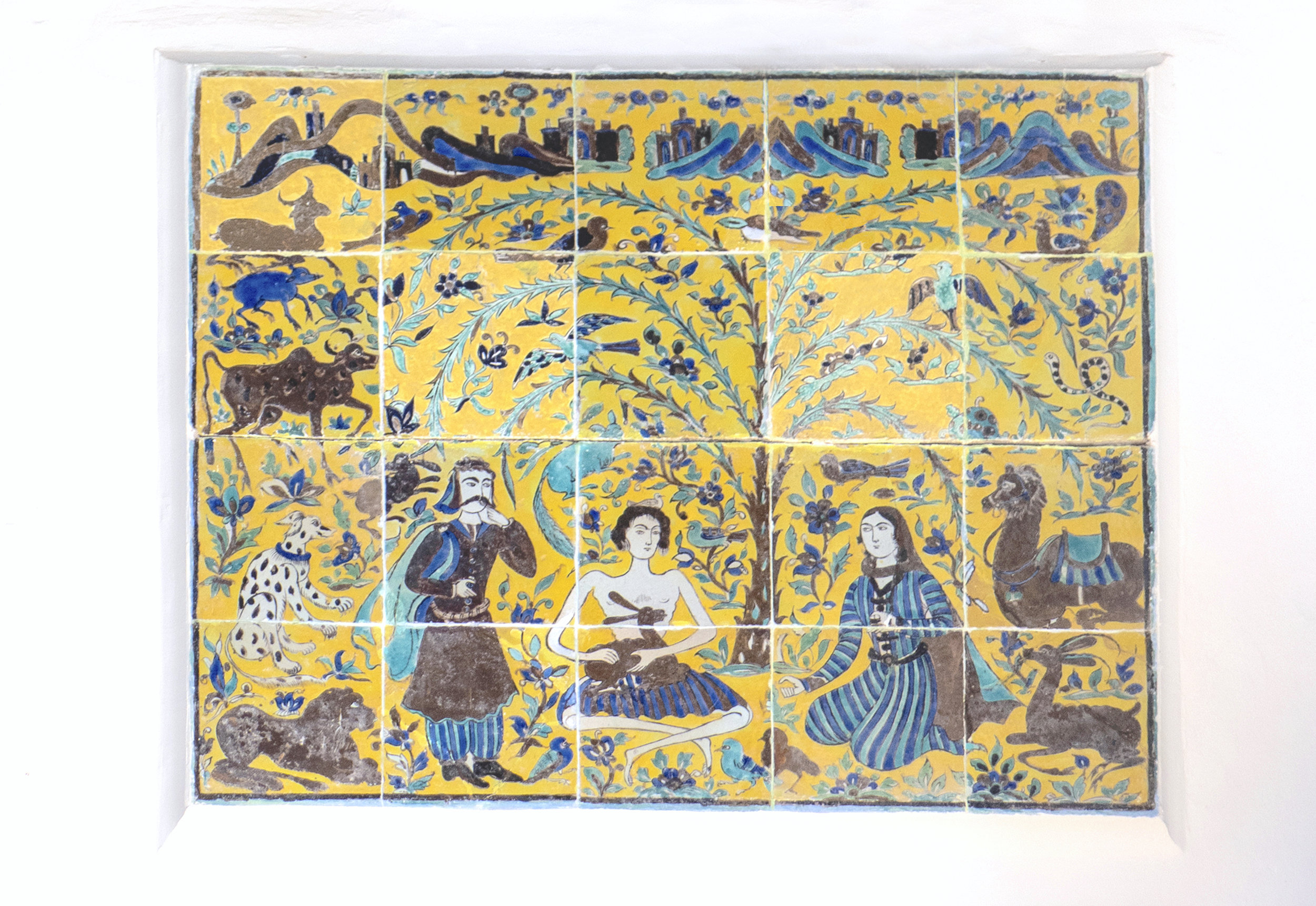
"Tile Panel with Layla and Majnun in the Wilderness," depicts a tragic story of undying love much like Romeo & Juliet; made in 19th c. Iran - stonepaste, polychrome glazes (40 x 49 1/2 in.).

From the central courtyard we entered the living room, whose west wall is a glass panel that descends fully into the ground and provides this view of Diamond Head and Shangri La's inner lawn area.

Relaxing on the inner lawn with friends ca. 1938 from left: Louis and Viola Kahanamoku, Anna Furtado and Sargent Kahanamoku, Doris Duke and Sam Kahanamoku. (Doris Duke Photograph Collection)

The living room’s coffered ceiling was custom-made for Shangri La in 1937 by Moroccan artisans using wood (cedar), pigments, gilding, and varnish; it measures 47 ft 1 3/4 in. x 23 ft. 10 in.

Shelves at the east end of the living room display Persian and Syrian ceramic vessels and storage jars dating from the eighth to seventeenth centuries.

Storage jar from 8th to 11th c. Iran. Earthenware and underglaze-painted (i.e., painted decoration applied before it is covered with a transparent ceramic glaze and fired in a kiln).
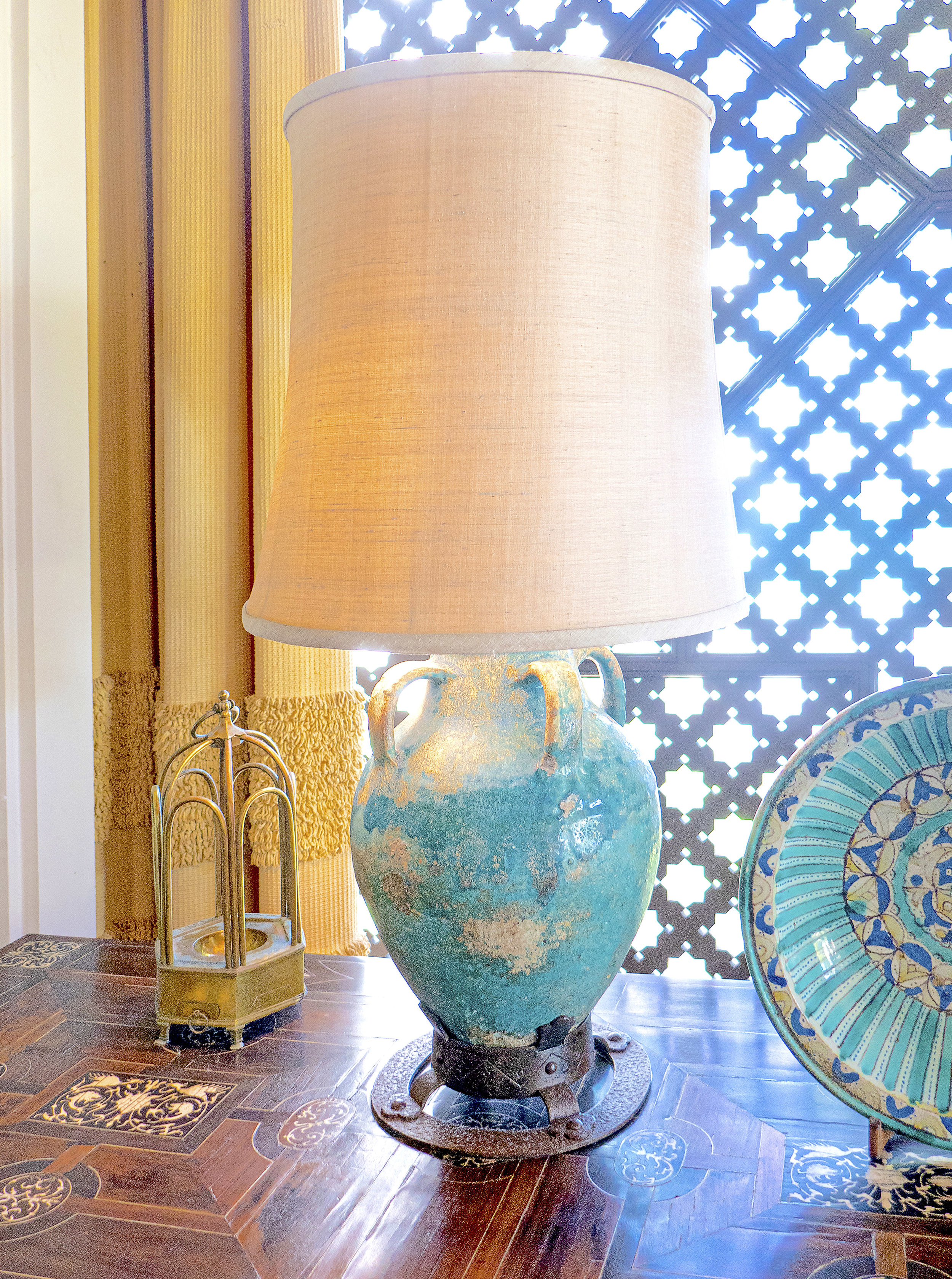
What do you do when you just have too many storage jars collected from the 8th to 17th centuries? For functionality, Duke decided to turn this one into a lamp.
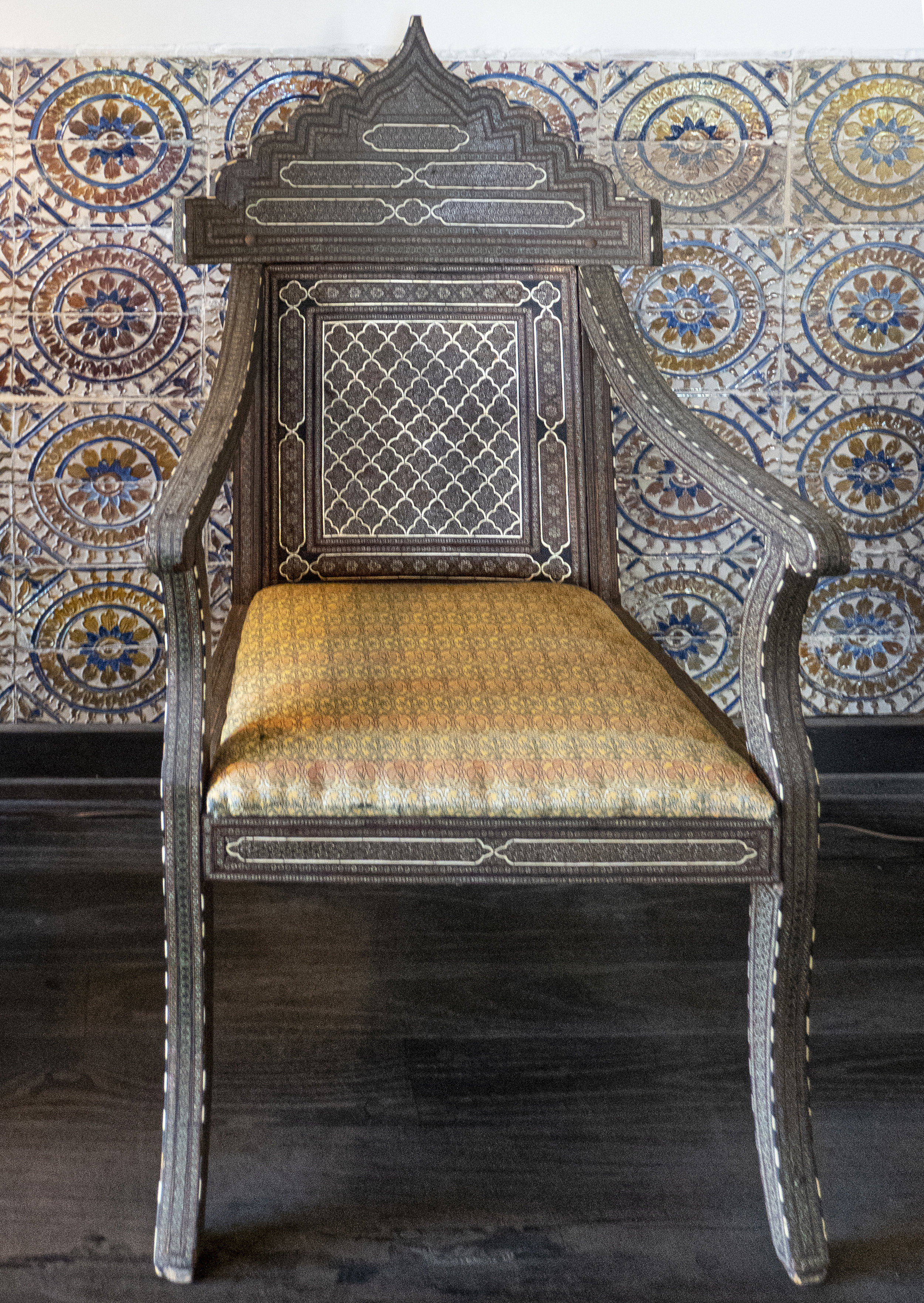
In the living room, an early 19th c. Iranian chair made of wood, bone, ivory, copper alloy, silver alloy, and with upholstery from Northern India (46 3/8 x 24 1/4 x 26 1/4 in.). BEAUTIFUL!
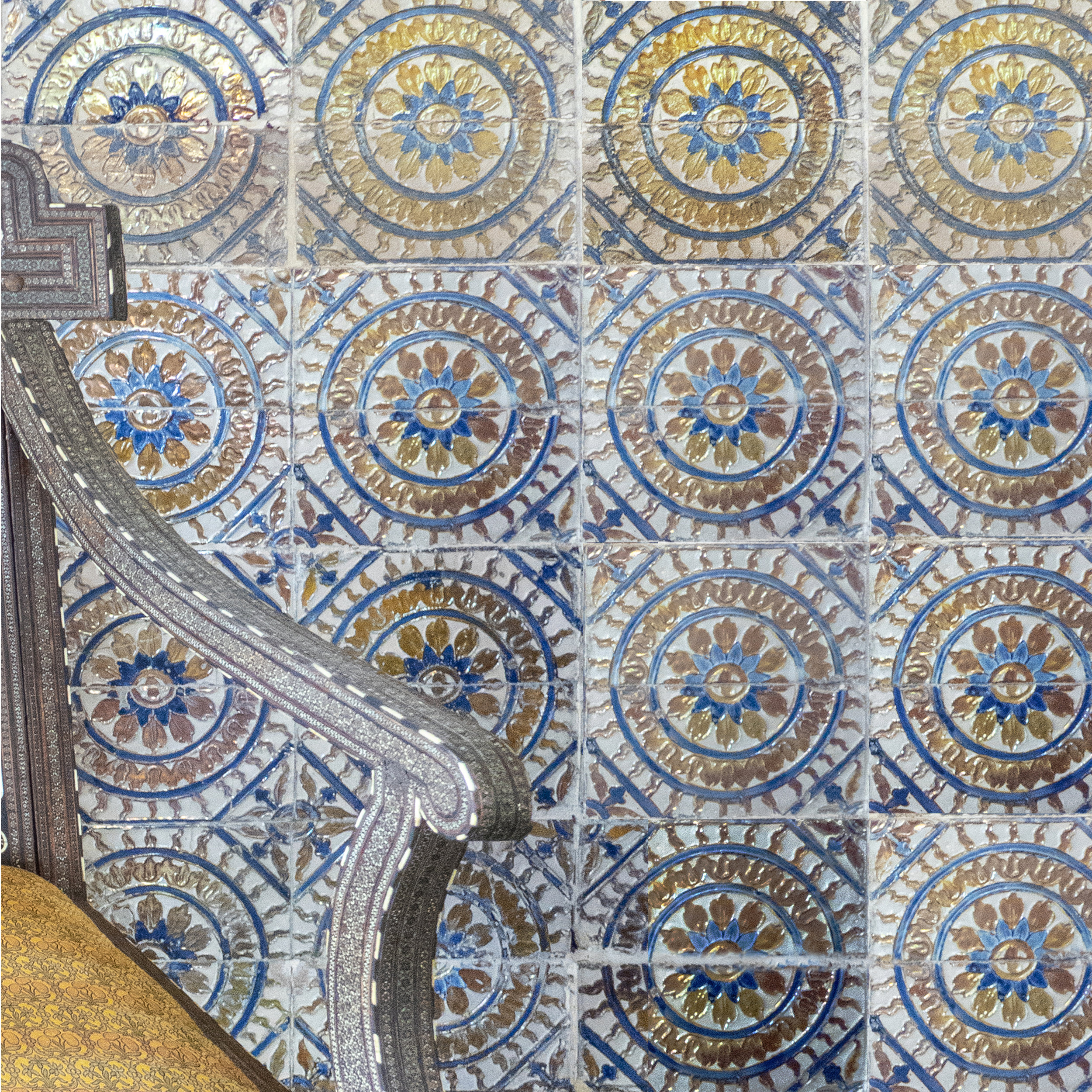
Tile from 1525-1550 Spain (Seville), made of earthenware, underglaze-painted & overglazed-painted in luster w/octagonal coffer design with a blossom surrounded by rayed circles (9 1/2 x 10 in).
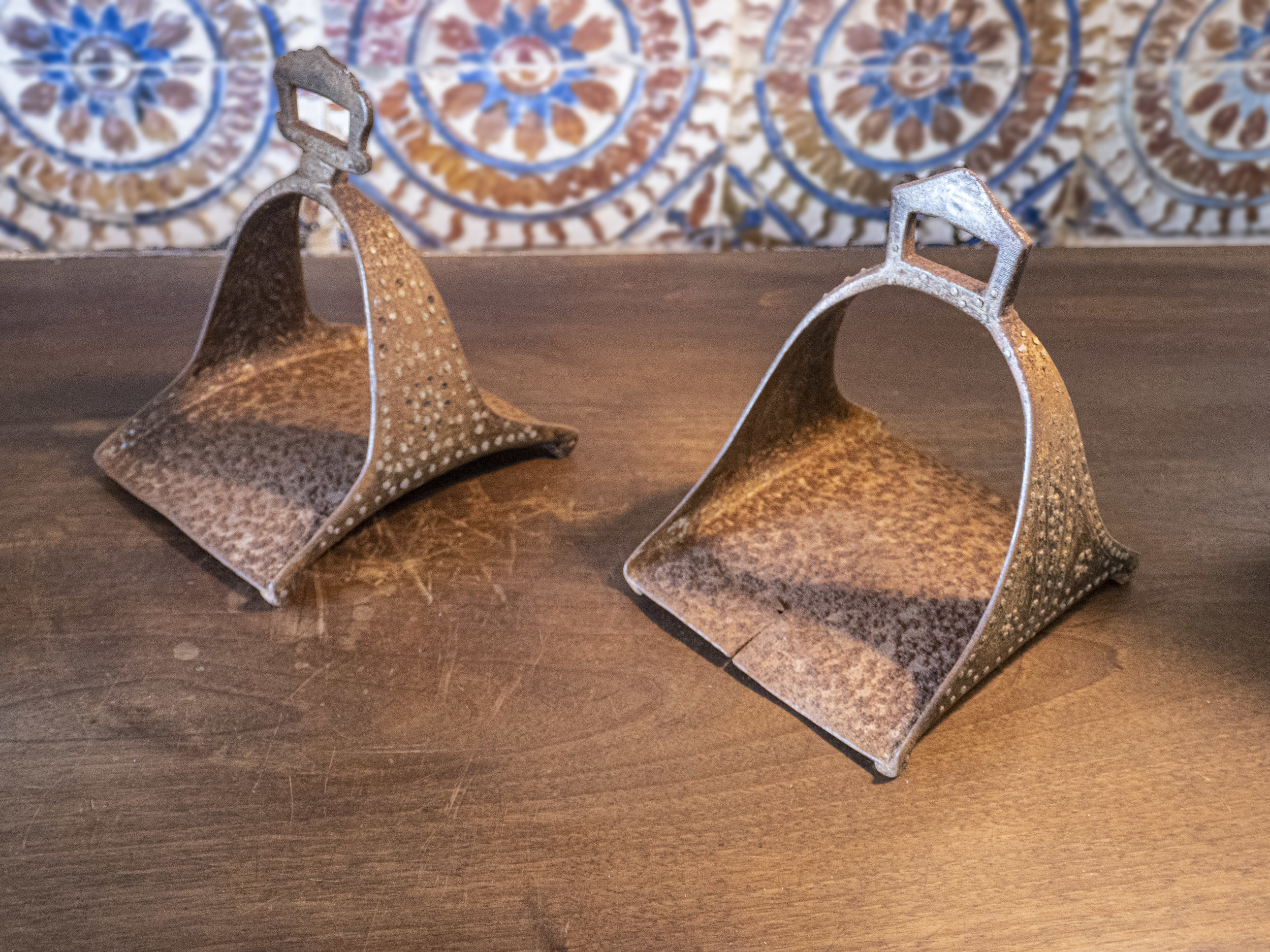
Possibly 19th c. stirrups from Ottoman Turkey. “The first stirrups seem to have spread from the Kushan Empire, 100 CE, to northern China, 3rd c., then to the western steppes of Iran (6th c.).”
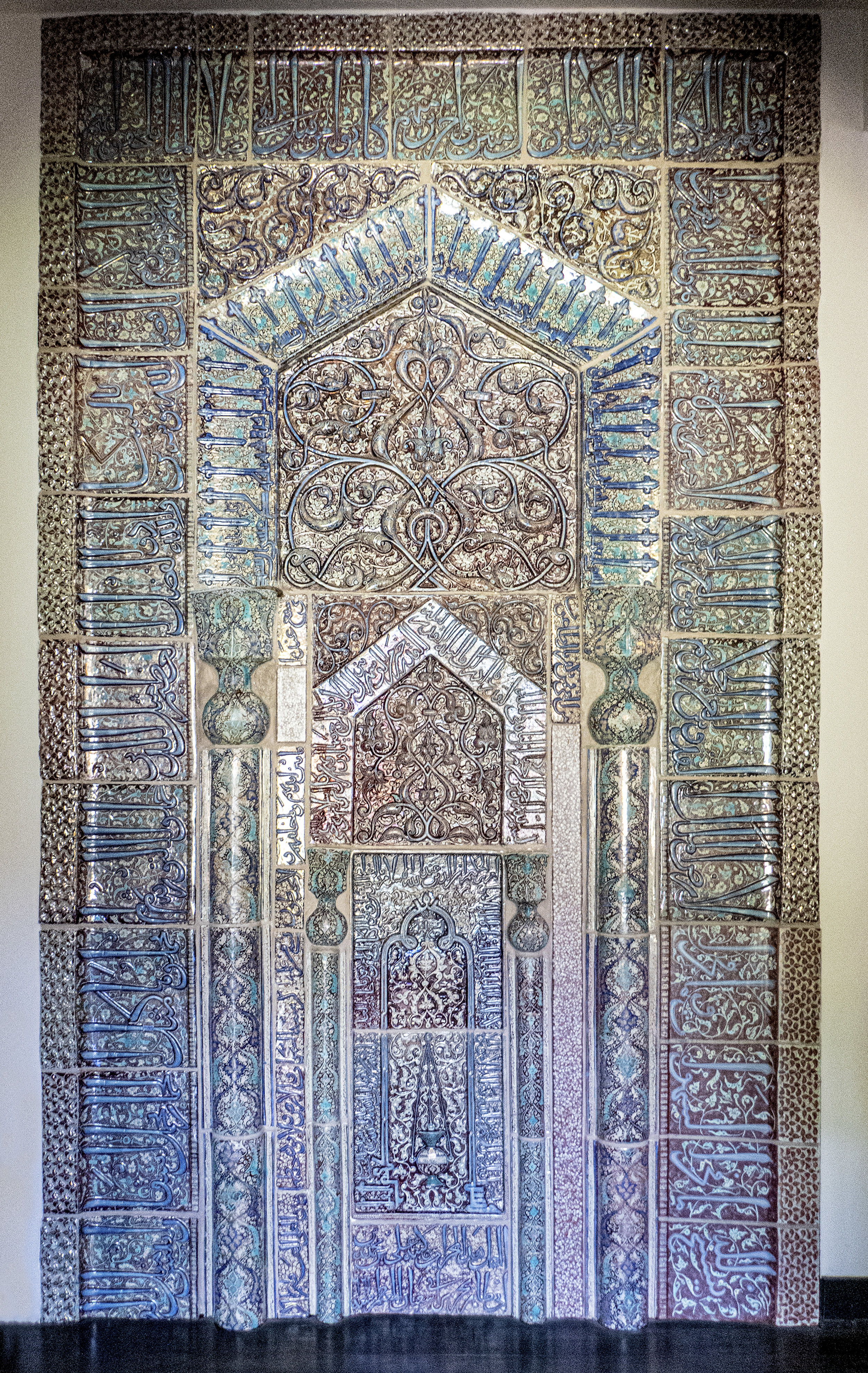
Veramin luster mihrab (prayer niche), Iran (Kashan), 1265 CE, 12.6 ft x 7.5 ft x 8 1/2 in. A mihrab is a recess or niche in a wall that indicates the direction of Mecca, thus the direction of prayer.
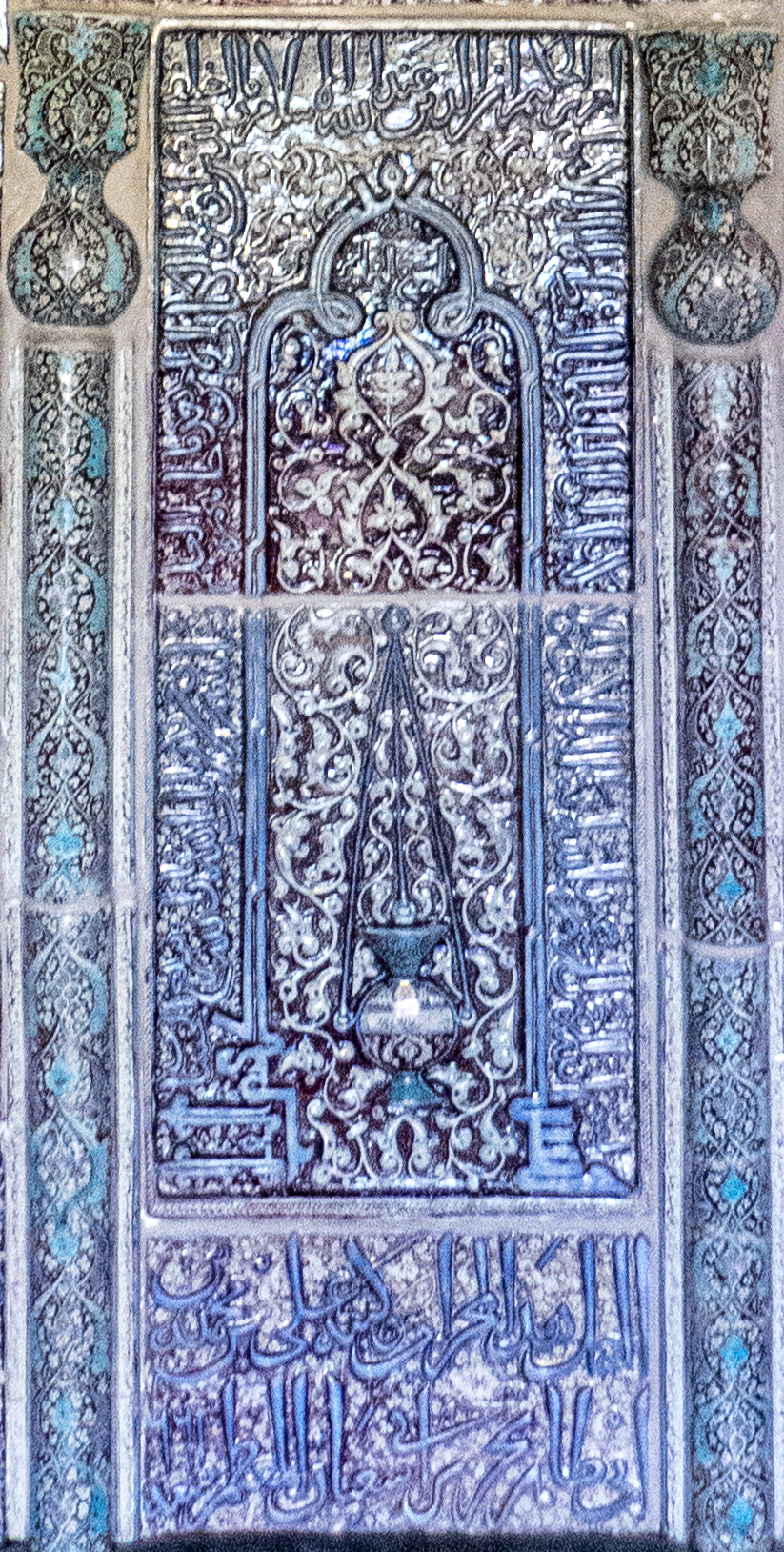
The bottom portion (middle) of the 13th c. mihrab includes a lamp hanging in a niche, a motif commonly found in Islamic art, since God (Allah) is likened to a lamp in a niche in the Qur’an (24:35).
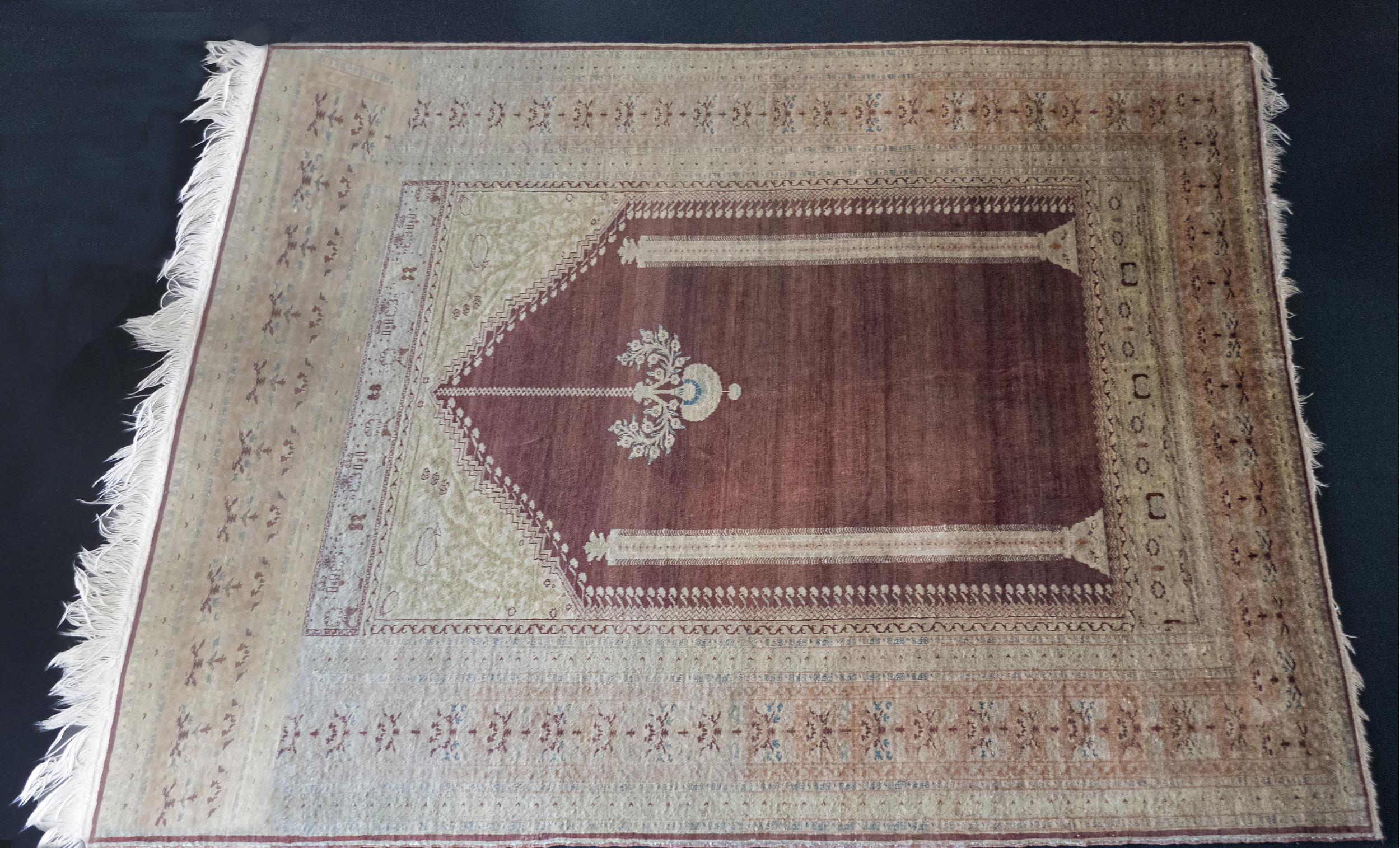
"Silk Prayer Carpet with Hanging Lamp Motif" from 19th c. Turkey, measuring 50 x 70 in. The point in the carpet's design is set toward the direction of Mecca for prayer.
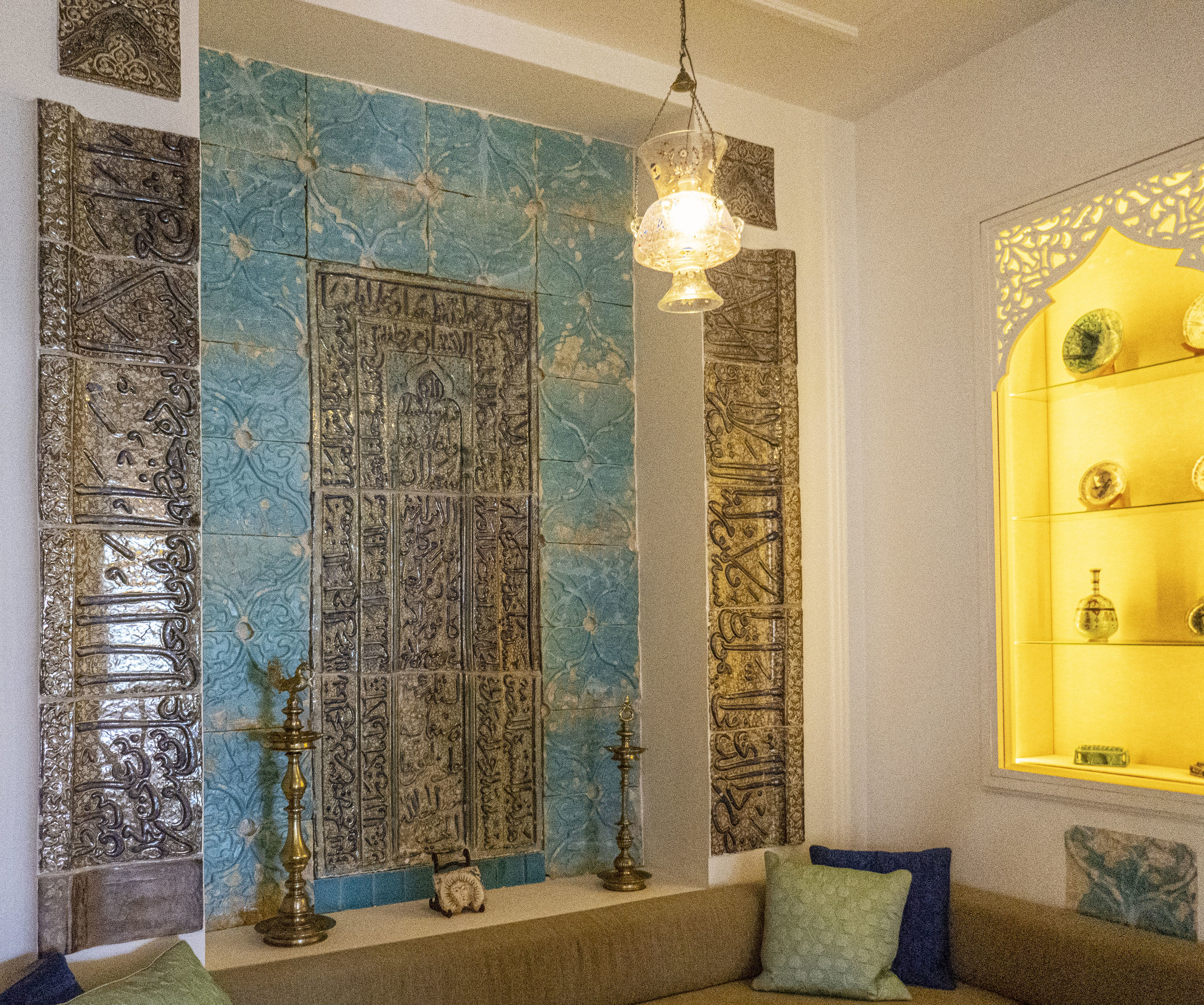
"Turquoise & Cobalt Blue-Glazed Molded Lusterware Tiles with Quranic Inscription," Iran, 1310 C.E. The inscription on this frieze is from the Qur’an’s well-known "Throne Verse" (2: 255)
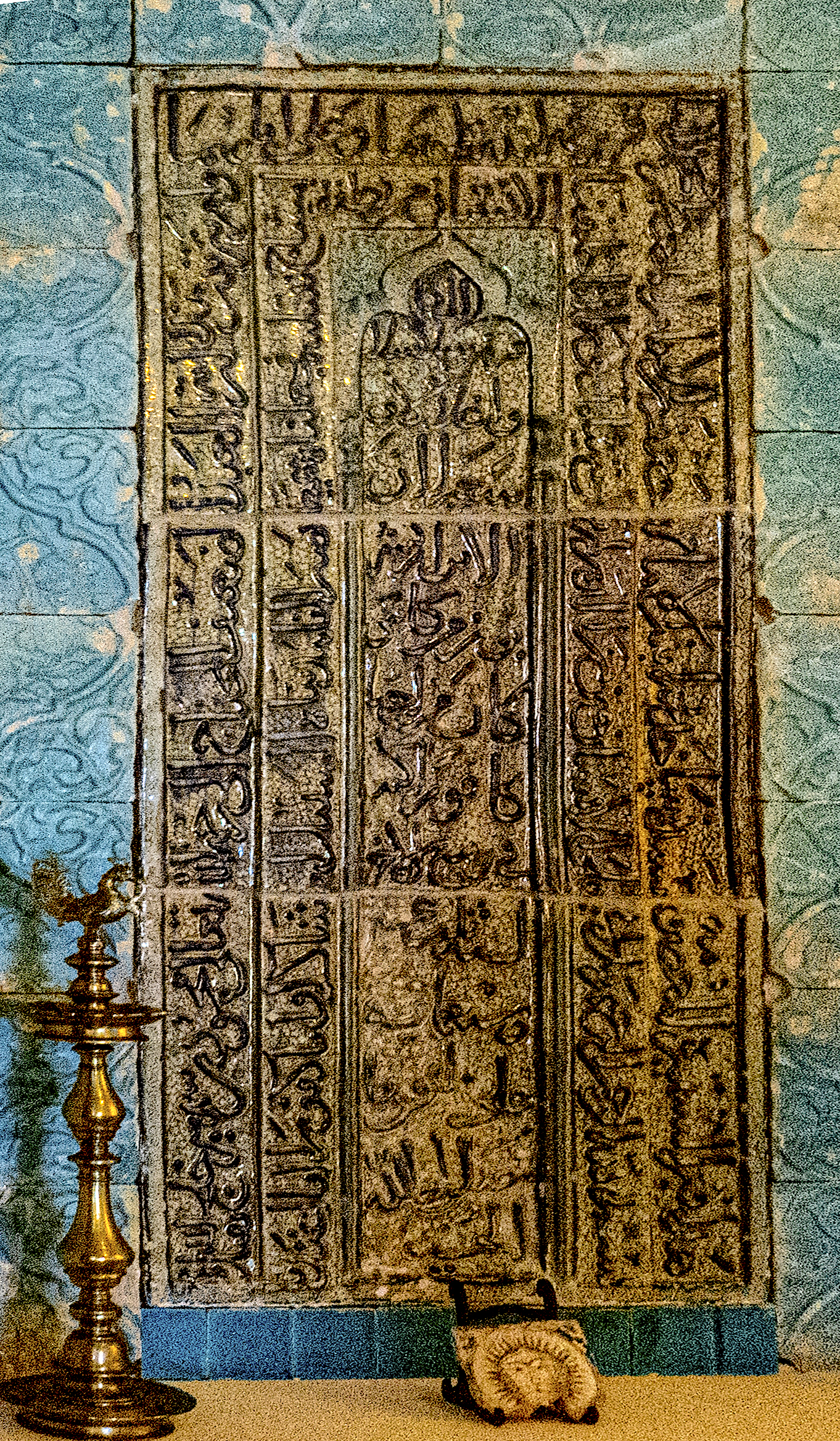
"Lady Khadija Tomb Cover," Iran, July, 1313 C.E., consists of three large luster tiles covered in cobalt calligraphy in relief, the latter includes verses from the Qur’an (76:1–4)
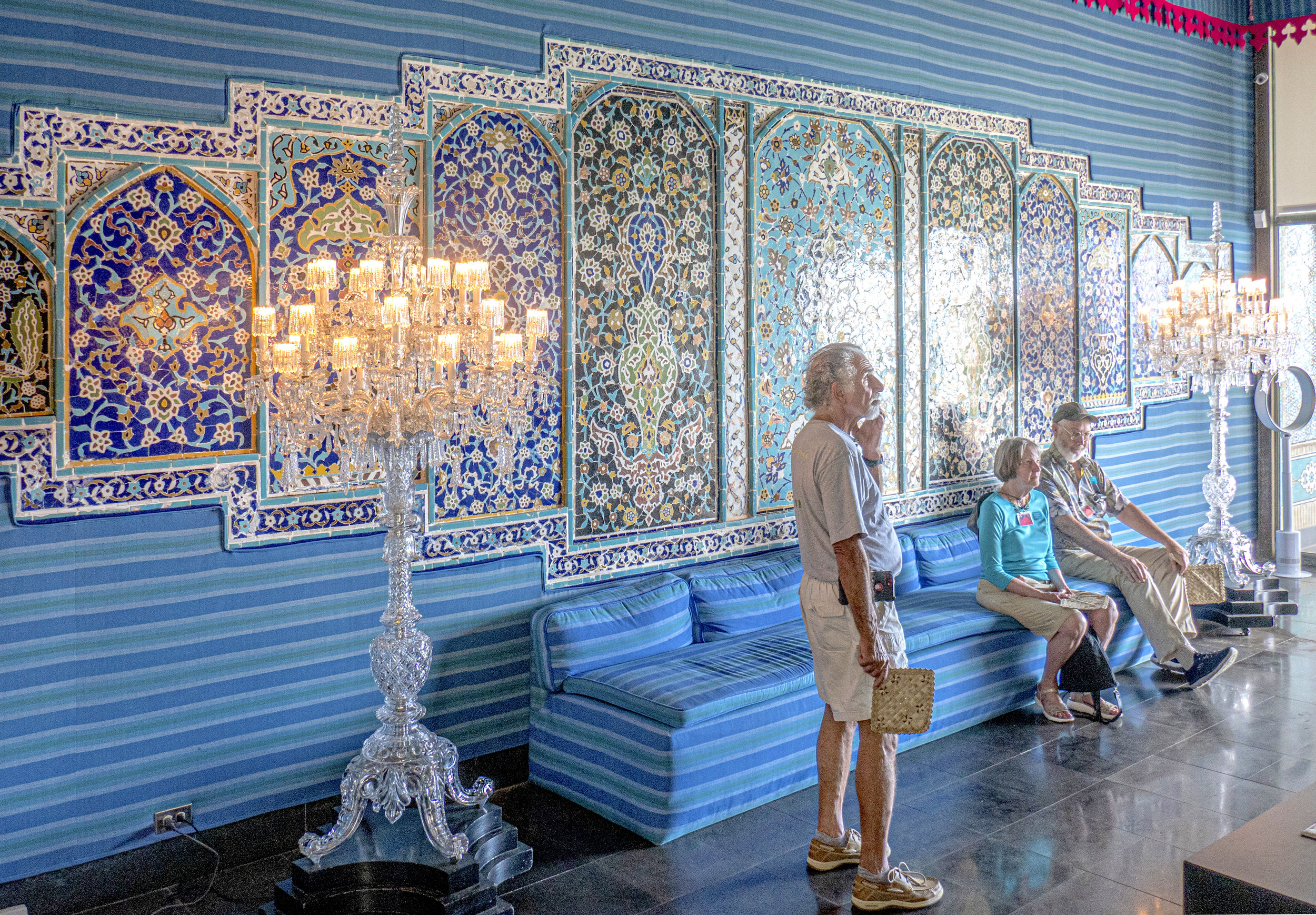
In 1938 Duke commissioned from Iran (Isfahan) the "Polychrome Mosaic-Tile Panel with Floral Motifs," shown here on the dining room wall (stonepaste, glaze; 26 ft x 7 ft, 1in).

The rather ornate (for my taste) dining room chandelier was made in France around 1840. It is comprised of color, as wells as, colorless glass and measures 80 x 60 in.
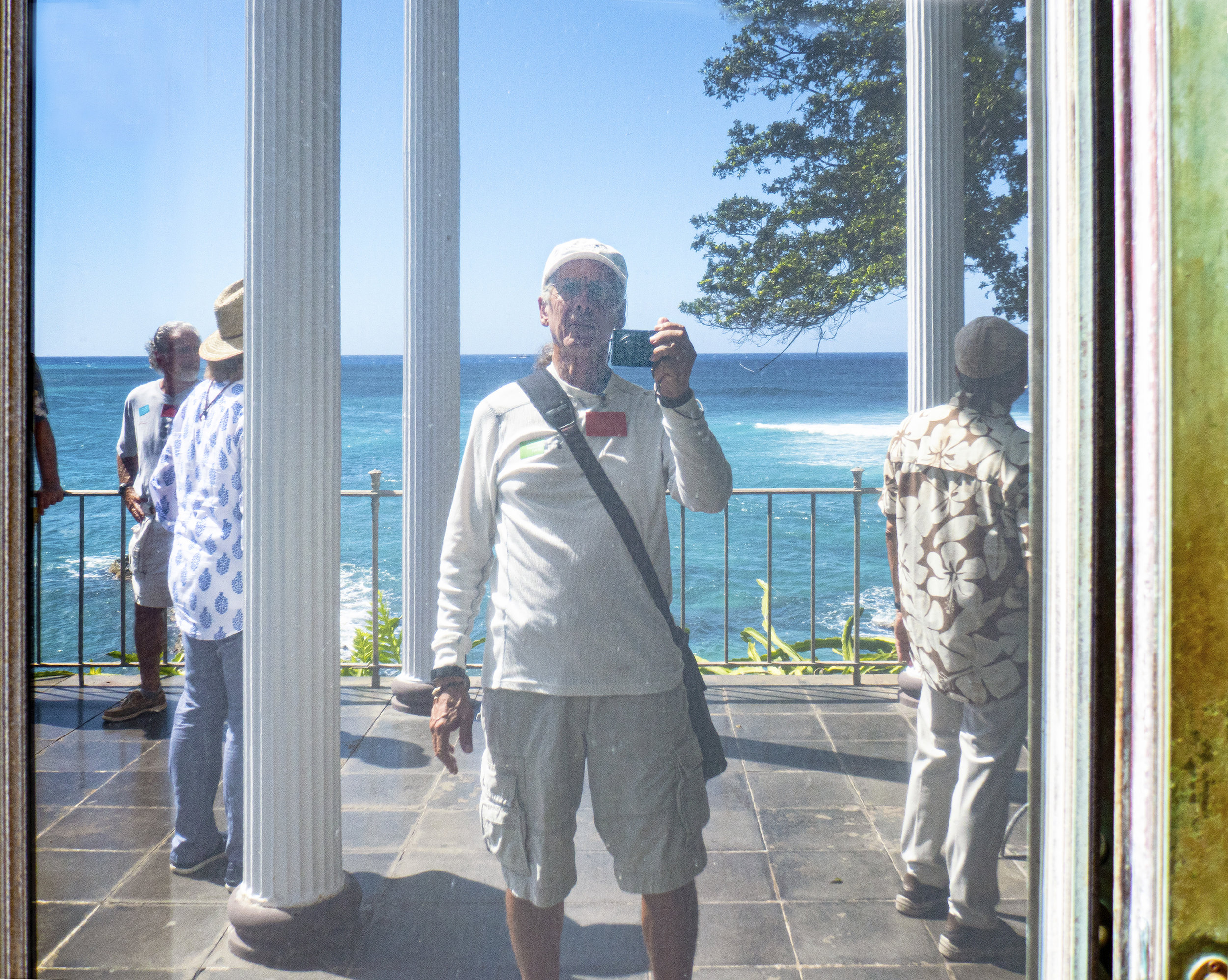
Standing on the dining room lanai, my selfie via the reflection of the dining room glass door.

Geometric forms were used by Islamic artists to stress the importance of unity and order. Mosaic tile panel on the lanai - Iran, probably 19th c., assembled as mosaic; 153 x 160 in.

Exterior view of Mughal bedroom suite (left), with the Jali Pavilion above, and dining room window (middle) with steps leading to the inner lawn.
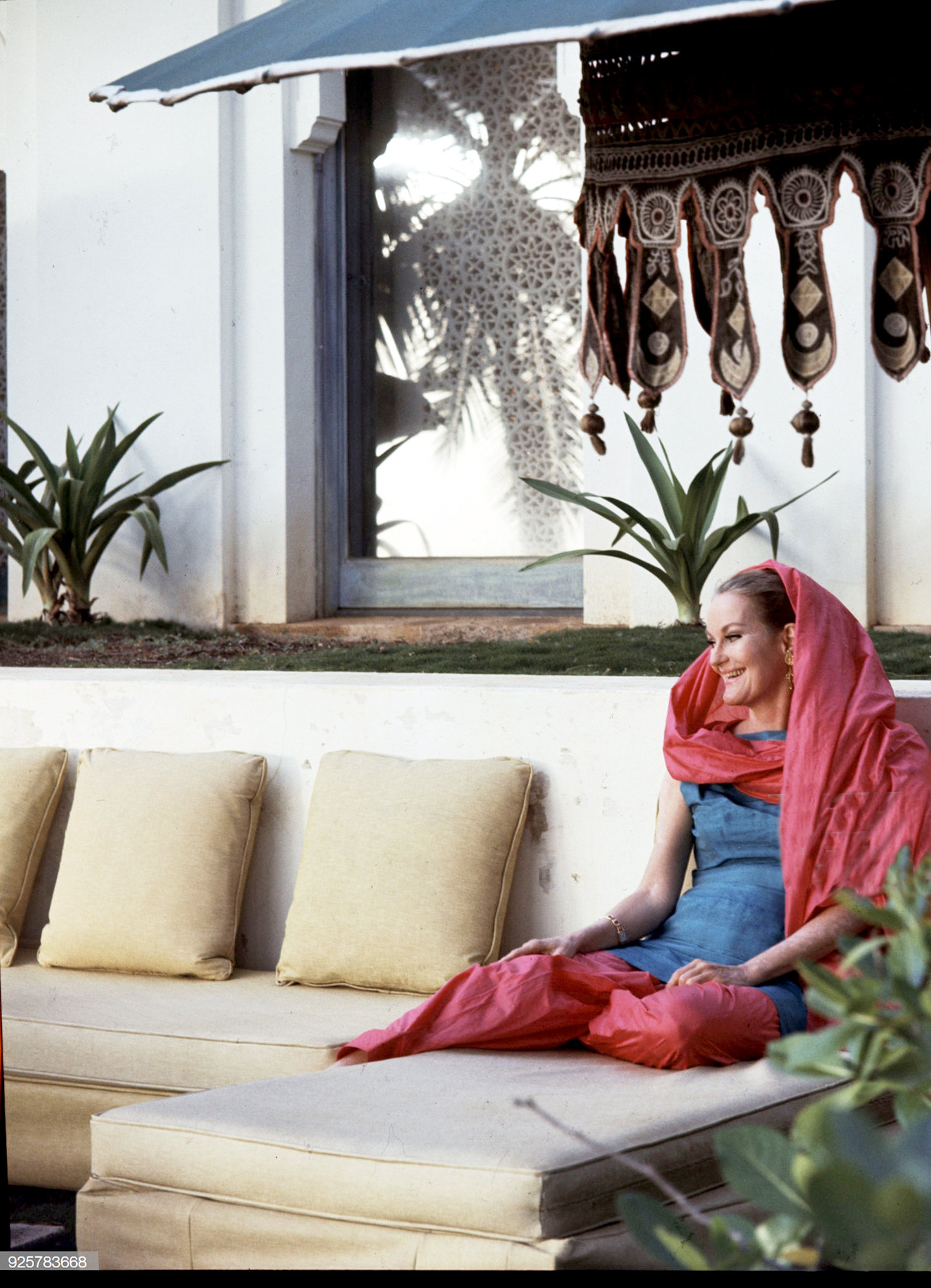
Vogue 1966, Doris Duke at home in her Shangri-La estate on Honolulu, Hawaii. (Photo by Horst P. Horst/Conde Nast via Getty Images)

Boat landing (rt), swim basin (middle), Diamond Head breaker adjacent to Shangri La, with Diamond Head Crater in the background.

With her canoe racing team Duke climbs into their outrigger for the Pualani Topping Canoe Race Offshore. Piloted by Sam Kahanamoku, with Duke as a "crewman," they finished first.

On the west end of the property and adjacent to the ocean, the Playhouse is a poolside pavilion inspired by the Chehel Sutun (c. 1647–50) palace in Isfahan, the capital of Iran from 1598 to 1722.
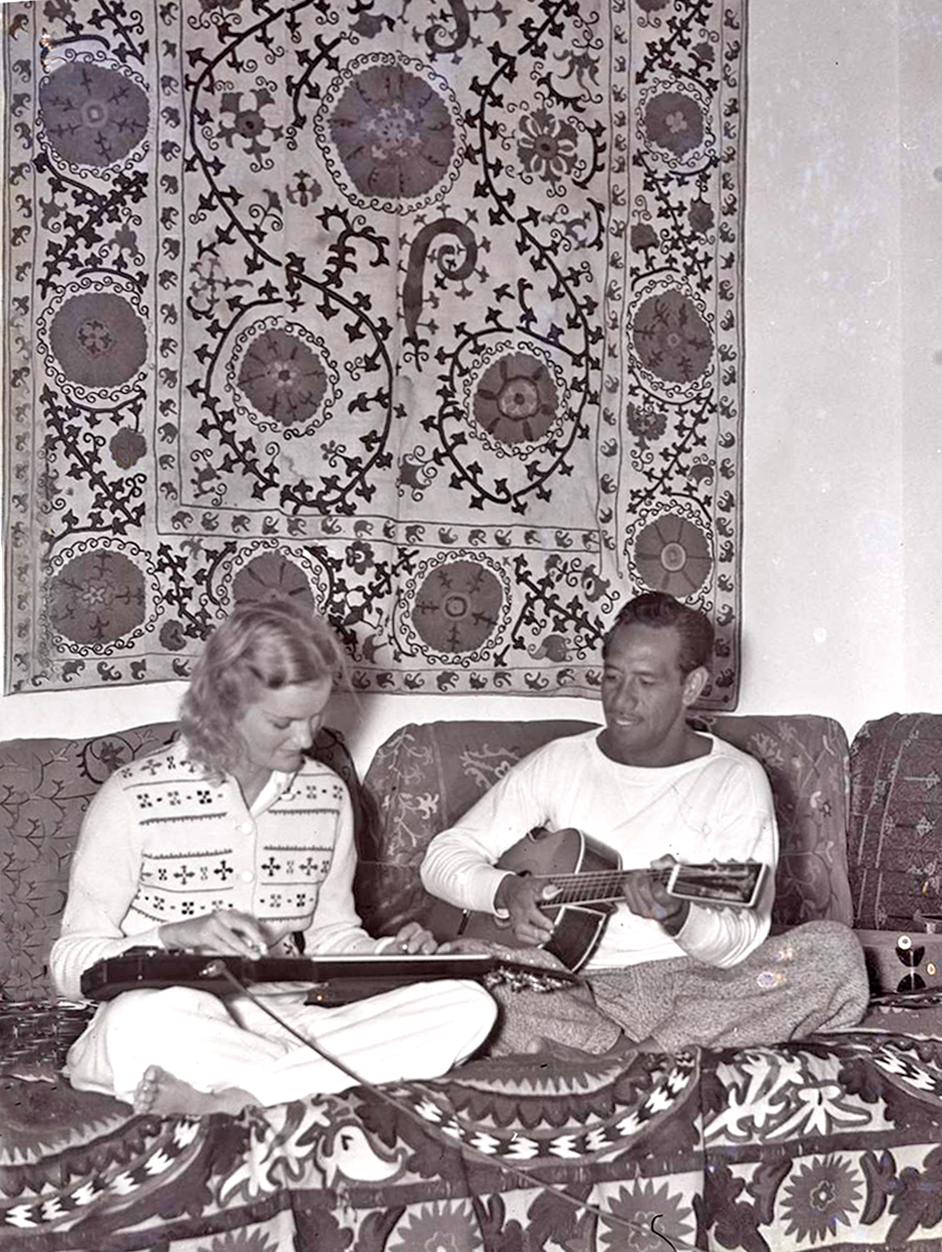
Doris Duke and Sam Kahanamoku playing guitars in the Playhouse, 1939. Photo by Martin Munkácsi.
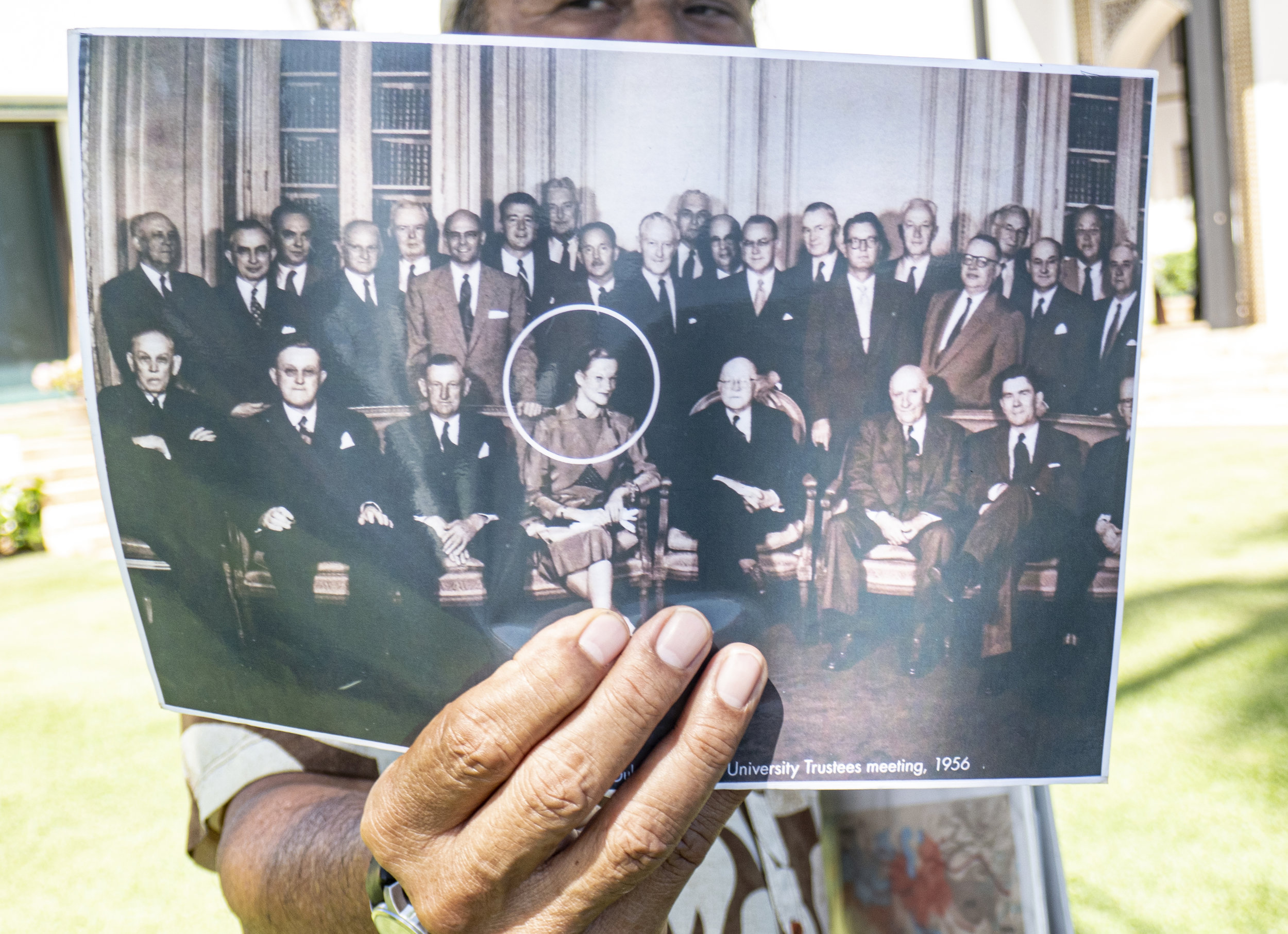
Our guide showed this picture of Doris surrounded by all men at Duke University Board of Trustees, 1956. Trinity College changed to Duke U. after her grandfather James donated $40million in 1924.
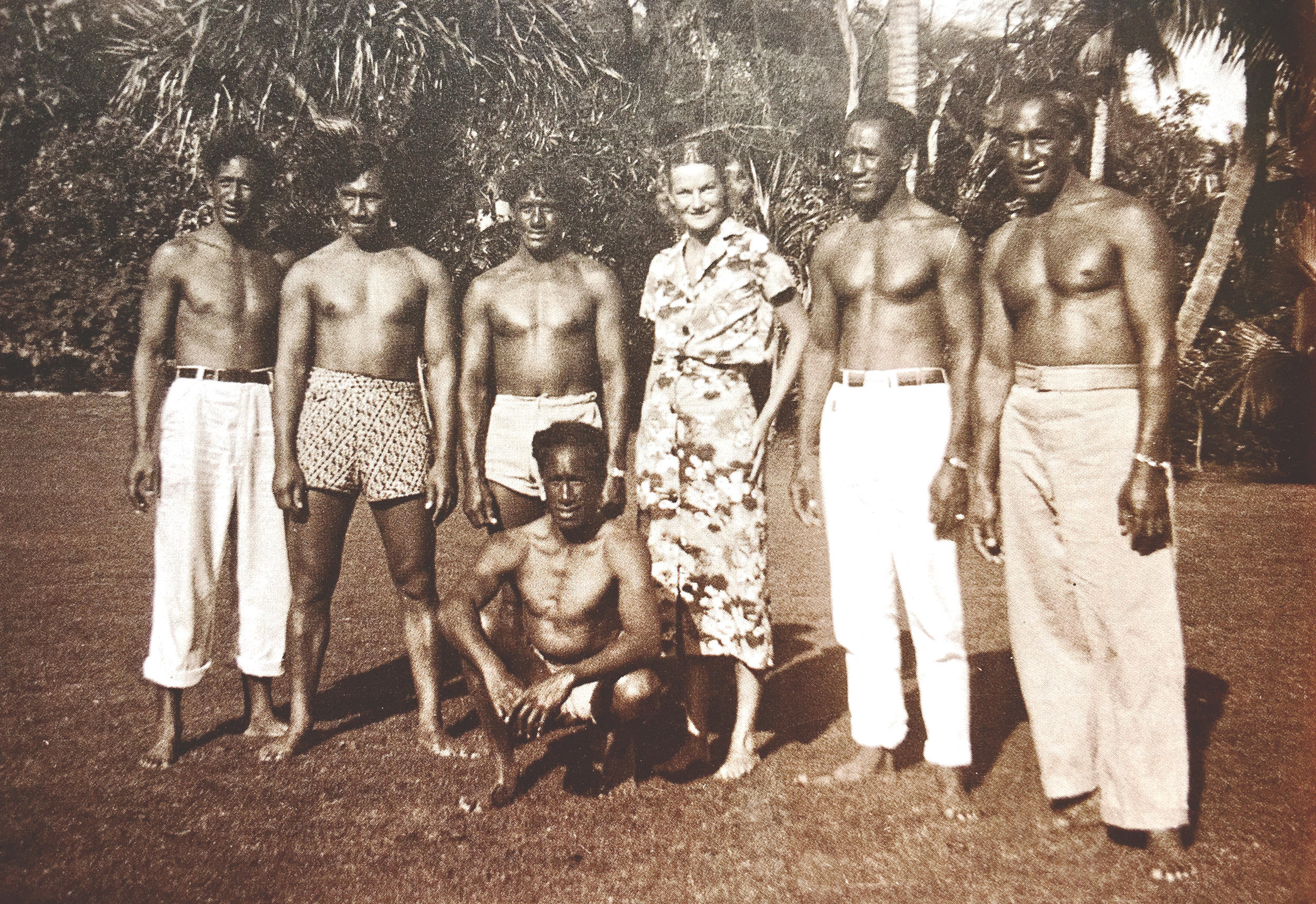
Doris Duke flanked by the Kahanamoku brothers, c. 1937 (left to right) Sargent, Louis, Sam, Bill (seated), Doris Duke, David, and Duke Kahanamoku (anonymous photograph)

Duke decorated this arch with "Polychrome Spandrel Tile Panel with Floral Motifs," which she commissioned from Iran (Isfahan) in 1938 (width: 82 in.). Stonepaste, glaze

The wonder of it all! The Syrian/Turkish Rooms contain "Polychrome Wooden Panels with Arabic Poetry Inscriptions" from 1854-1855 CE. The decor is mostly from the Quwwatli family house in Damascus.
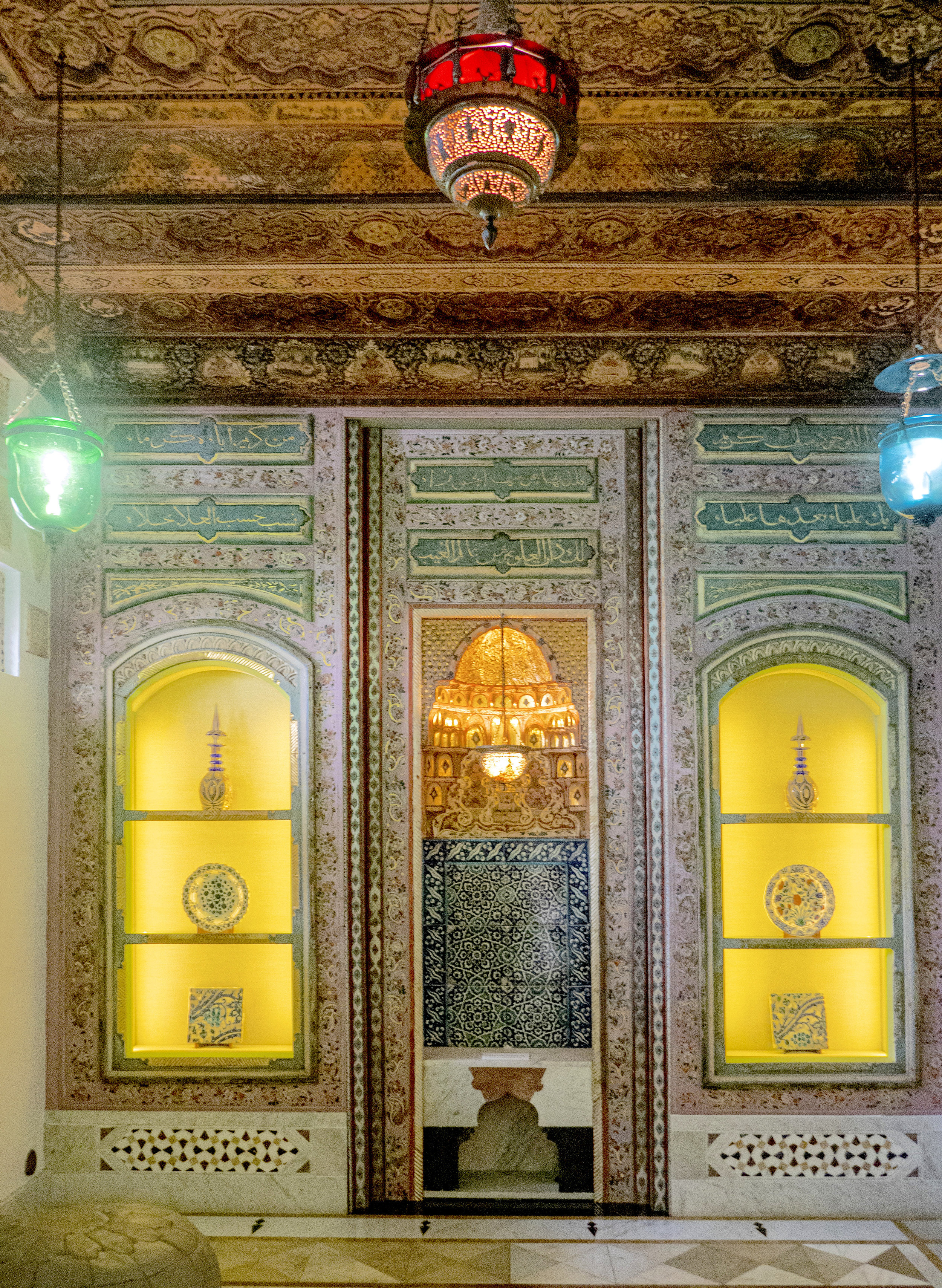
The "baby" Syrian Room includes wall elements (pink framing panels, calligraphic cartouches) framing a niche (masab). The wood is painted, gilded, with metal leaf & translucent glazes.
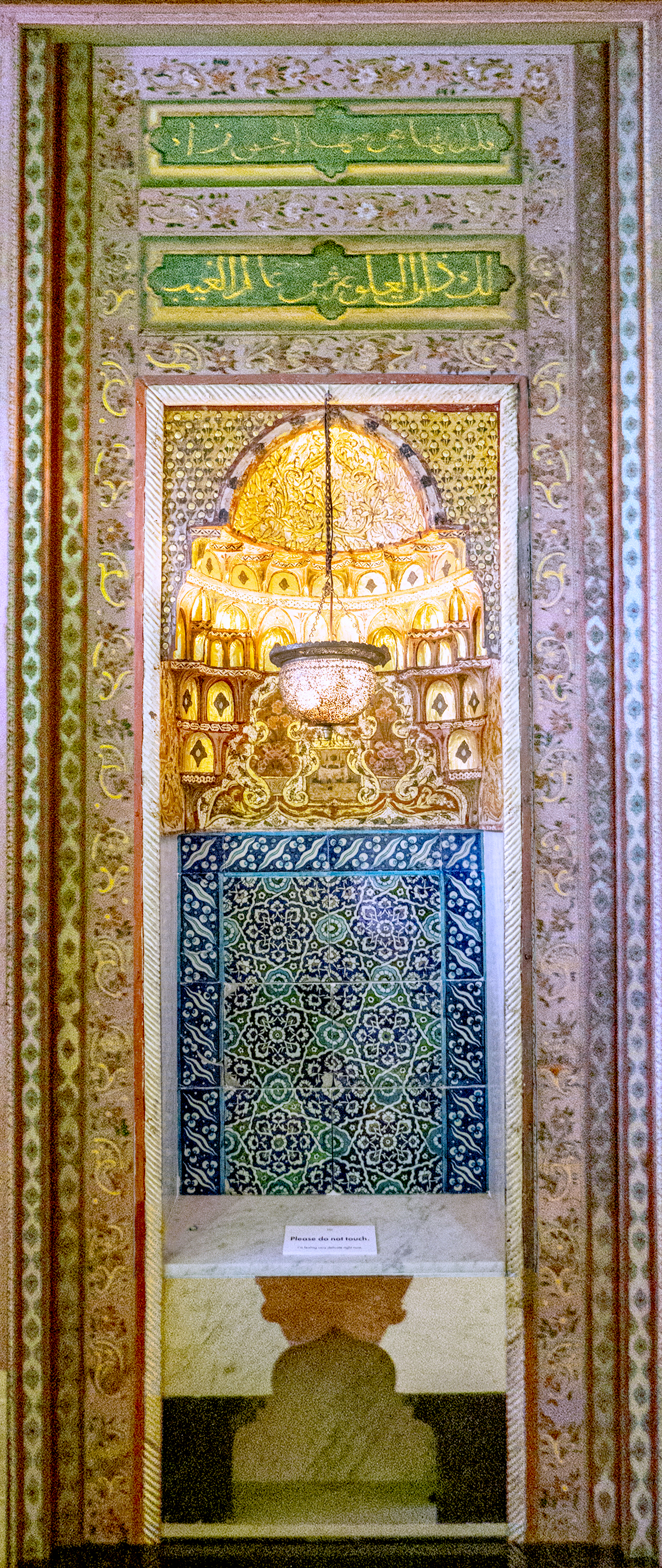
A prominent feature of historic Syrian interiors was an elaborate wall niche (masab) where cherished objects could be displayed.
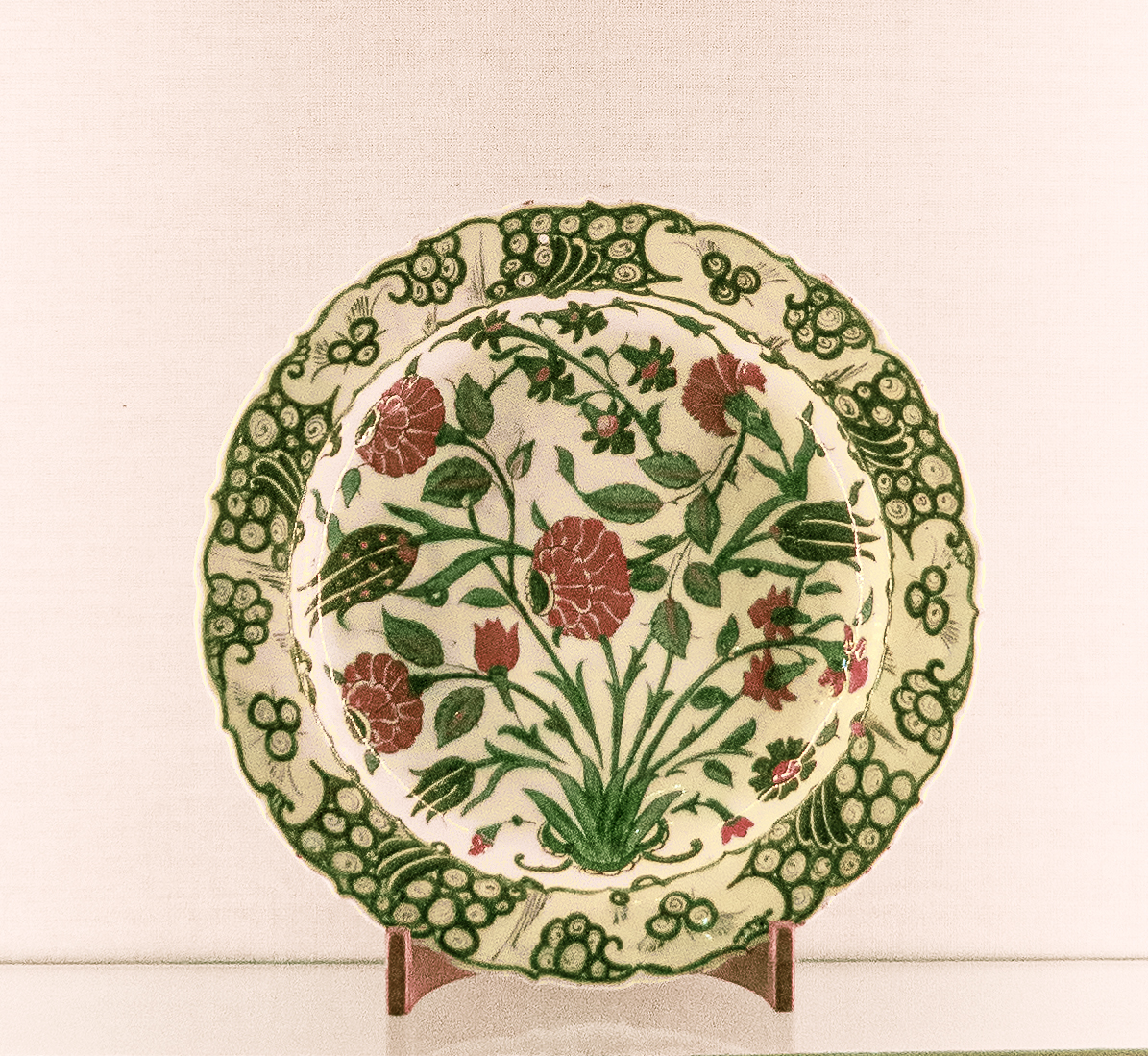
"Cusped-Rim Polychrome Ceramic Dish with Floral and Saz Leaf Motifs" from 16th c. Turkey (Iznik). In the 1950s and 1960s, Duke purchased a number of Iznik dishes at auction in New York.
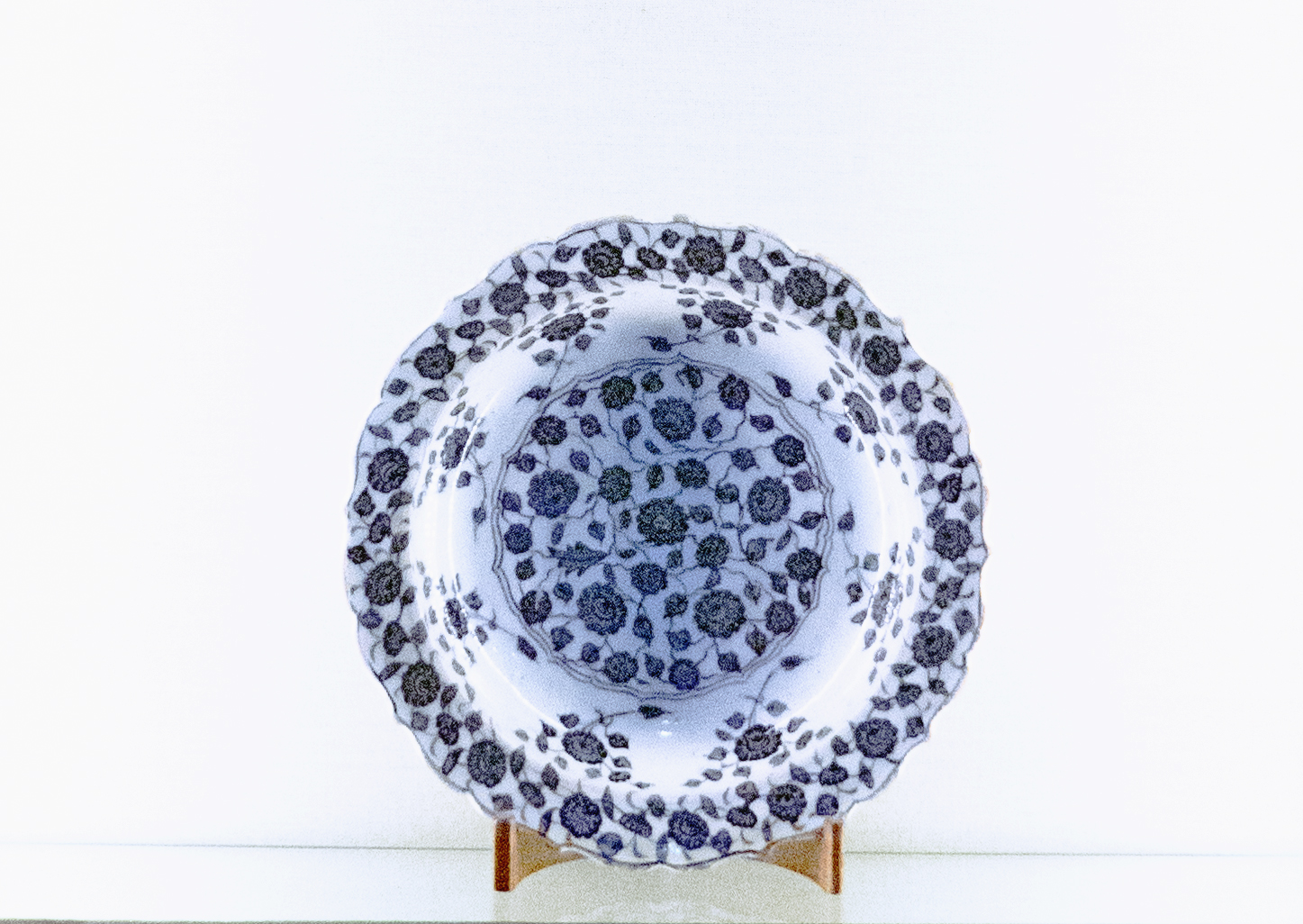
Also from 16th c. Turkey (Iznik), in the vitrine next to the masab is this "Blue and White Ceramic Dish with Floral Motifs" (11 1/2 in. diameter; Stonepaste, pigments).
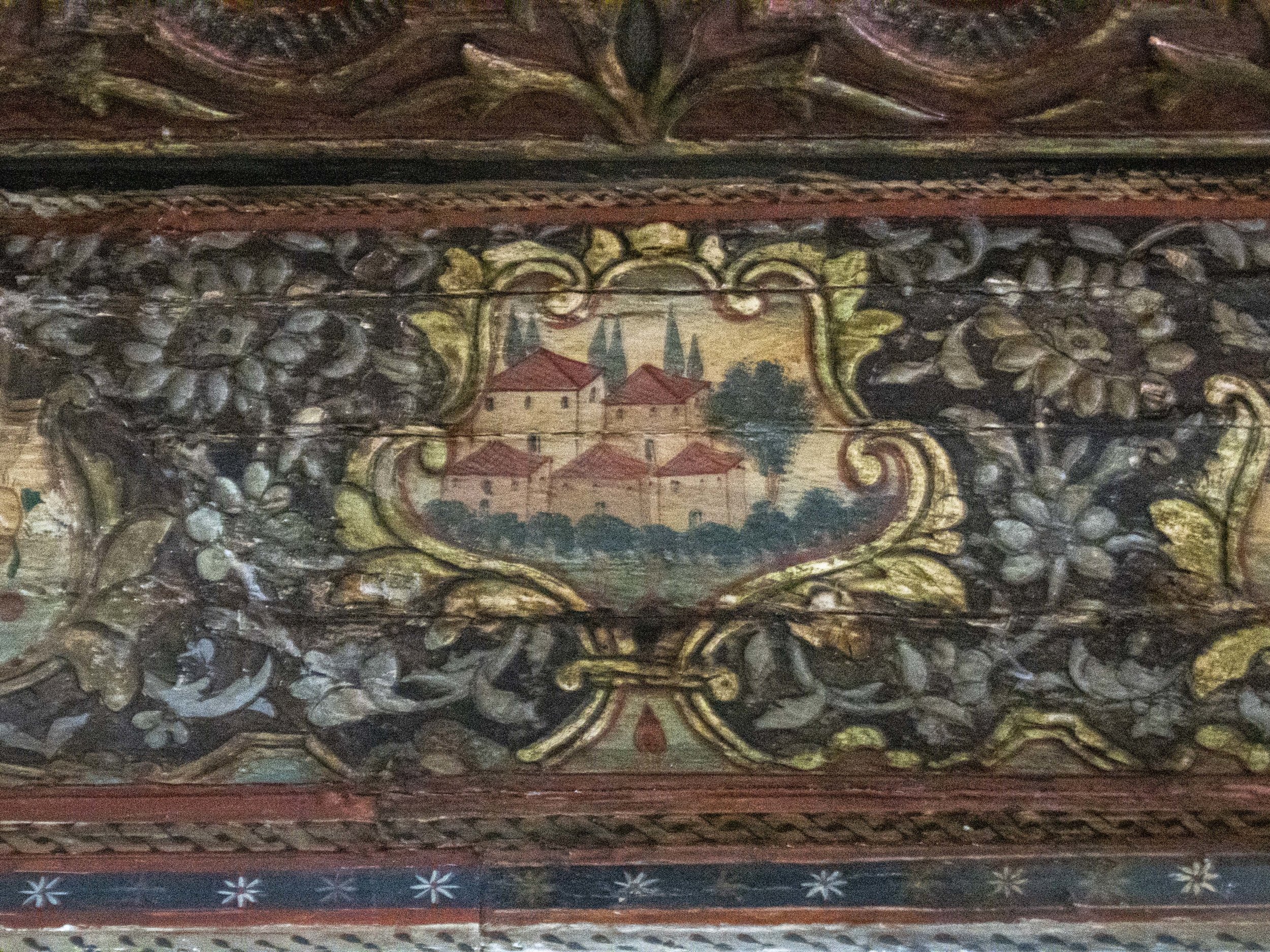
Details of the painted wood panels originally in the Quwwatli house in Damascus, Syria, now in the baby Syrian Room
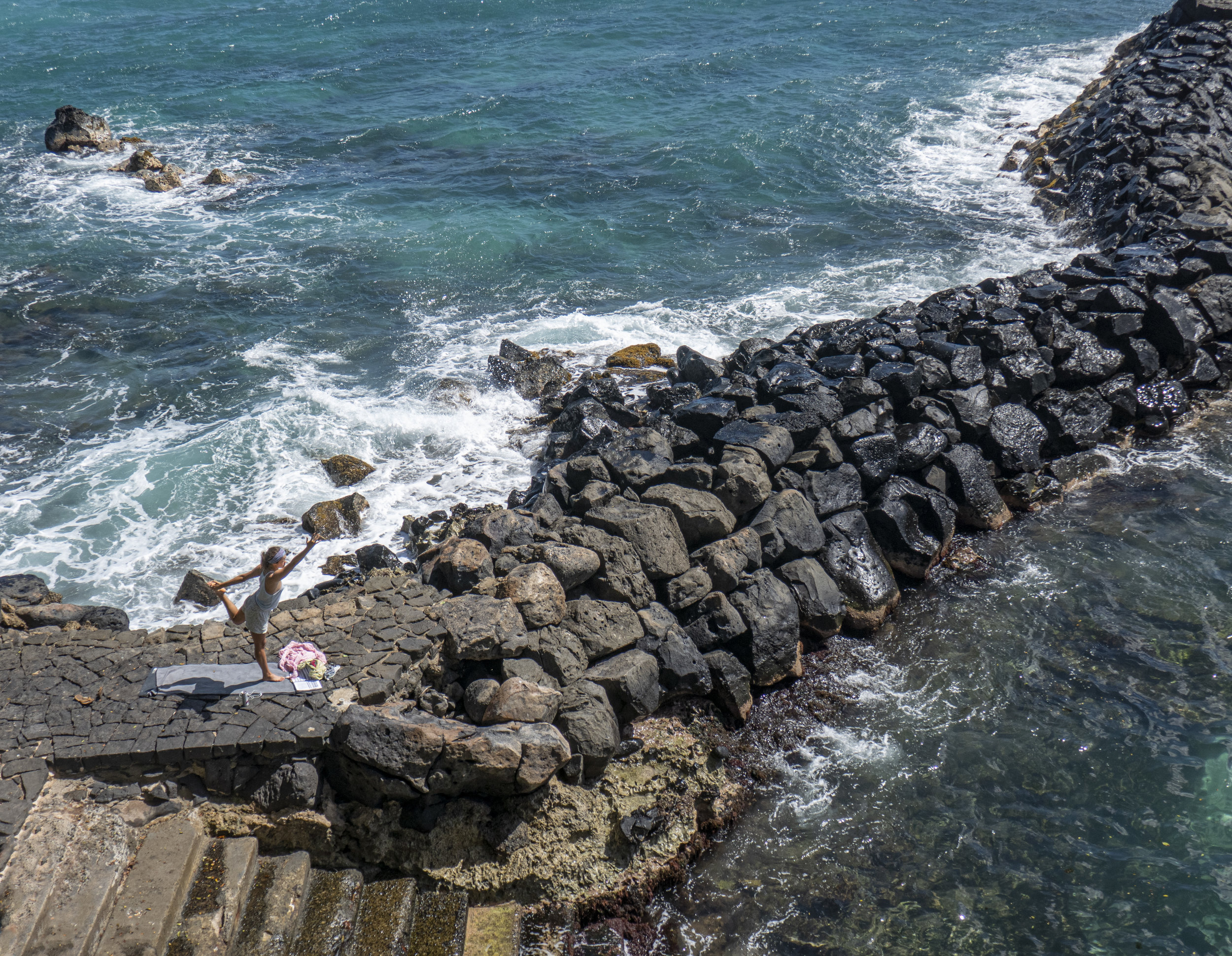
During my visit I saw this young woman doing yoga on the Shangri La rock breakwater.

Doris Duke enjoyed the area as one of Kahanamoku brothers casts his fishing net. Duke became the first non-Hawaiian woman to take up competitive surfing under the tutelage of the Kahanamokus.
PrevNext